




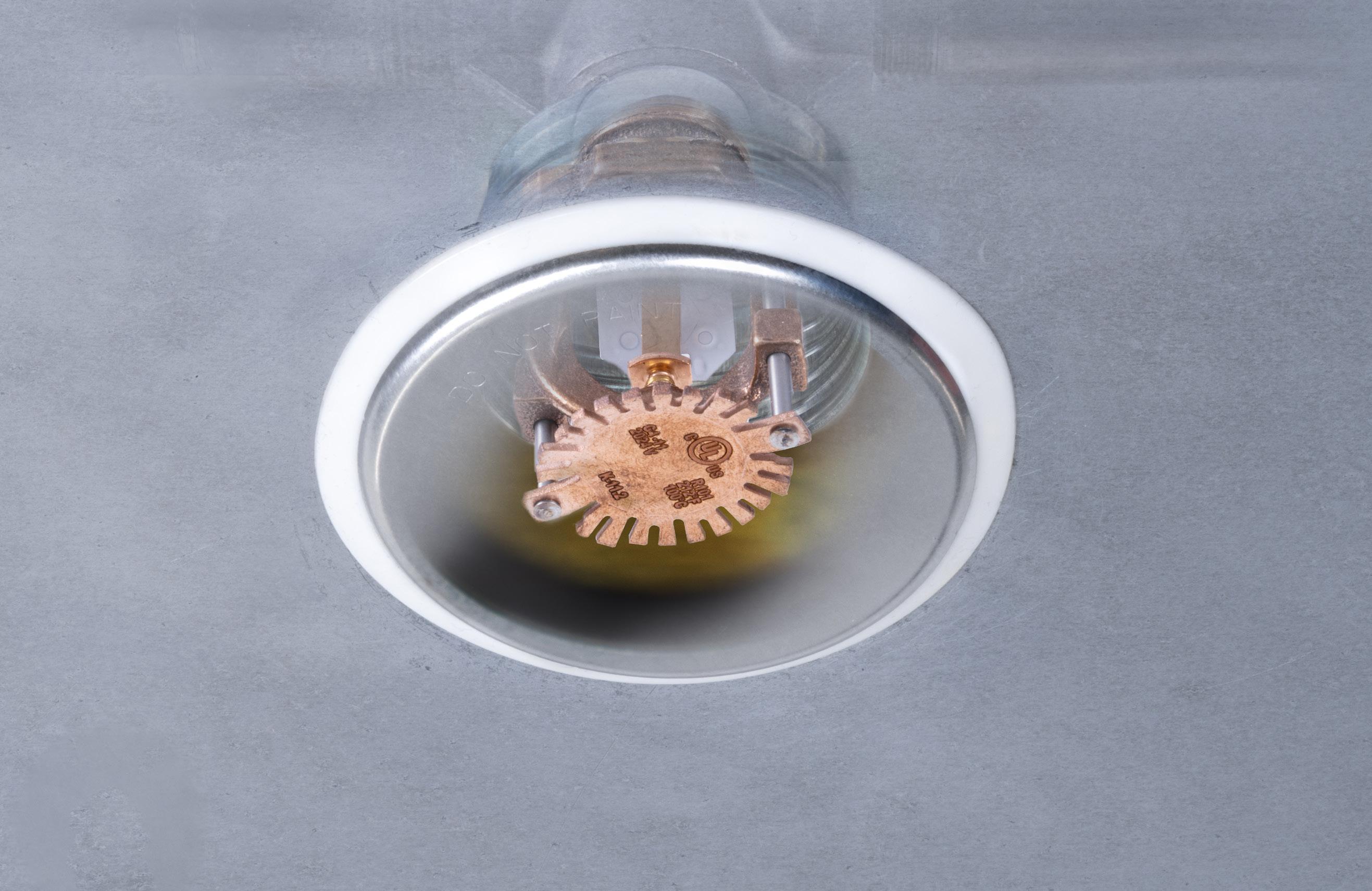
Durable fusible link operating element
Gasketed cover plates limit air and dust movement through the ceiling
for industrial clean room applications

for traditional Extra Hazard applications

The industry’s ONLY lineup of rugged standard response fusible element K11, K14 and K17 spray sprinklers. And introducing the new G4-11 concealed sprinkler with a gasketed flat plate for industrial clean room applications or other finished areas.

Our new mill expands our overall product capabilities, giving us the most comprehensive range of sprinkler pipe in the industry:
• Diameters from 1” to 10” NPS.
• Schedule 10, 30, 40, and Eddy Flow (size dependent)
• Lengths up to 25’, with custom lengths available
Plus a variety of finishing options — not to mention our exclusive EddyGuard II® MIC antimicrobial coating to help ensure reliable flow for years.
It’s all available to you from a single, responsive supplier…making your pipe selection job much easier.

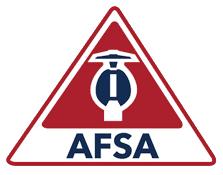
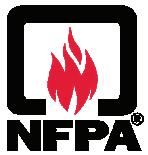




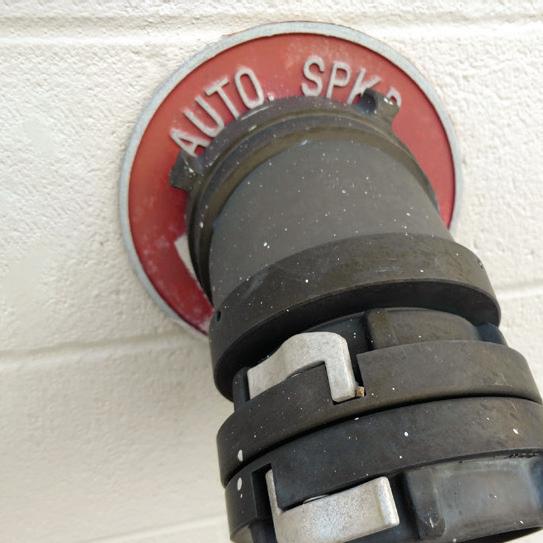



















First, I must say WOW! WOW how fast this year has passed. WOW to the amazing AFSA Board, committee members, staff, contractors, and associate members. And WOW to all of the amazing things that have been accomplished by the aforementioned group. I hope you all are enjoying the AFSA43 convention in the Mile High City—Denver, Colo. This year is one for the books, AGAIN, with over 1,400 attendees! Woohoo! A huge thank you to our Convention Chair, Don Kaufman, the committee, and AFSA’s Roger Gragg for stepping up to make this a tremendous success!
It is my honor to posthumously recognize Joe Heinrich with this year’s Henry S. Parmelee Award, AFSA’s highest honor. This award is given in recognition of an outstanding individual who has dedicated themselves to the professional advancement of the fire sprinkler industry and to the goal of fire safety through automatic sprinklers. I want to extend my congratulations to his son, Brett, and our dear friend, Kathy Heinrich. His legacy will live on.
Thank you all for supporting the first Women in the Industry panel discussion and reception, and I hope for many more. I would like to personally thank my fellow panelists, Taylor Johnson, president, Atlanta WinSupply; Lainey Liotta, senior manager, BlazeMaster; and Katie Meehan, director of marketing, VSC Fire & Security, for being a part and being women leaders in the fire sprinkler industry. Their journey would inspire any young woman to join our industry.
As I reflect on my time as Chair thus far, I realize that it has been an adventure of a lifetime. Many of the goals the Board set are being accomplished. As Chair, one goal I have is to try to attend as many AFSA chapter meetings as possible. I have visited the North Carolina and Louisiana Fire Sprinkler Chapters, and plan to attend the Virginia, Arkansas, and Schuylkill Chapter meetings before the end of the year. This gives me an opportunity to visit with members and chapter leaders to share AFSA news. Thank you for the invitation! I may not make it to all 30 chapters, but I know I will give it my all.
One of the many AFSA success stories is the development and expansion of our existing apprenticeship training program. Today, we have a state-of-the-art, hands-on training facility and training rooms to provide live classroom training that comes straight from our expert instructors. AFSA’s Virtual Instruction Program (VIP) leads the way to ensure your apprenticeship team is trained, letting you focus on “on-the-job training.” A new Level 2 class begins on Oct. 8, 2024. Classes fill up quickly, so register now and see the difference.
In closing, our convention, seminars, and special events would not be possible without the support of you, our members. THANK YOU for supporting your association and our industry. A big THANK YOU to our diamond sponsors: ASC, Core and Main, Ferguson Fire & Fabrication, Reliable, Victaulic, and Viking. They believe in our mission to educate and train the industry while promoting fire protection systems to save lives and property. We are the industry leaders in training the fire sprinkler workforce, so we get the best of the best in seminar speakers. Thank you for donating your time to advance the knowledge of our industry.
Last but certainly not least a special THANK YOU to the AFSA staff led by President Bob Caputo. They have worked tirelessly to bring you a fantastic time with world-class training, led by John Denhardt. Thank you to Roger Gragg, Josh Fisher, Leslie Clounts, Veronica Westfall, D’Arcy Montalvo, Victoria Valentine, Christina Sales, Josh McDonald, Kevin Hall, Meda Merritt, Melissa Athens, and Eric Andresen. It’s another successful convention in the books! n
BOB CAPUTO, CFPS, Publisher, ext. 124 bcaputo@firesprinkler.org
D’ARCY G. MONTALVO, Editor, ext. 115 dmontalvo@firesprinkler.org
ADVERTISING:
CLARISSA RIOS, Communications Coordinator, ext. 134 crios@firesprinkler.org
CIRCULATION:
D’ARCY G. MONTALVO, Editor, ext. 115 dmontalvo@firesprinkler.org
AFSA BOARD OF DIRECTORS
LINDA M. BIERNACKI, Chair, 318-841-0330
PAUL DELORIE, First Vice Chair, 603-432-8221
JAY STRICKLAND, Second Vice Chair, 301-474-1136
ROD DIBONA, Treasurer, 605-348-2342
JEFF PHIFER, Secretary, 803-438-2994
JACK A. MEDOVICH, P.E., Immediate Past Chair, 804-222-1381
BROOKS BAYNE, 503-692-9284
TOMMY CLEMENTS, 804-459-2218
LYLE HALL, 858-513-4949
CHRIS JOHNSON, 727-5821-9339
R. DONALD (DON) KAUFMAN, 505-884-2447
MICHAEL F. MEEHAN, 804-459-2200
WAYNE WEISZ, 209-334-9119
BOB CAPUTO, CFPS, President, ext. 124
MELISSA ATHENS, Vice President, Finance, ext. 112
LESLIE CLOUNTS, Vice President, Education Services, ext. 130
JOHN AUGUST DENHARDT, P.E., FSFPE, Vice President, Engineering & Technical Services, ext.121
MEDA MERRITT, Vice President, Membership & Chapter Development, ext. 133
ROGER GRAGG, Director, Marketing & Information Technology, ext. 116
Sprinkler Age is devoted to the professional development of the fire sprinkler industry. Deadline is 1st of the month preceding publication.
Published by American Fire Sprinkler Association, 1410 East Renner Road, Suite 150, Richardson, TX 75082. Call (214) 349-5965, FAX (214) 343-8898, or email sprinklerage@firesprinkler.org for information.
Copyright © American Fire Sprinkler Association, Inc. All rights reserved. PRINTED IN USA. Unless expressly stated otherwise, all editorial and advertising material published is the opinion of the respective authors and/or companies involved and should not be construed as official action by or approved by Publisher or the Association.
Sprinkler Age is a membership benefit, provided free of charge to AFSA members. For information on non-member and/or foreign subscription rates, call (214) 349-5965.
LINDA M. BIERNACKI AFSA BOARD CHAIR

AFSA annual membership dues are a sliding scale for Contractors and Associates and a flat fee for Authorities Having Jurisdiction. (Members receive a free subscription to Sprinkler Age.) Write or call AFSA for membership information. See AFSA’s website at firesprinkler.org.
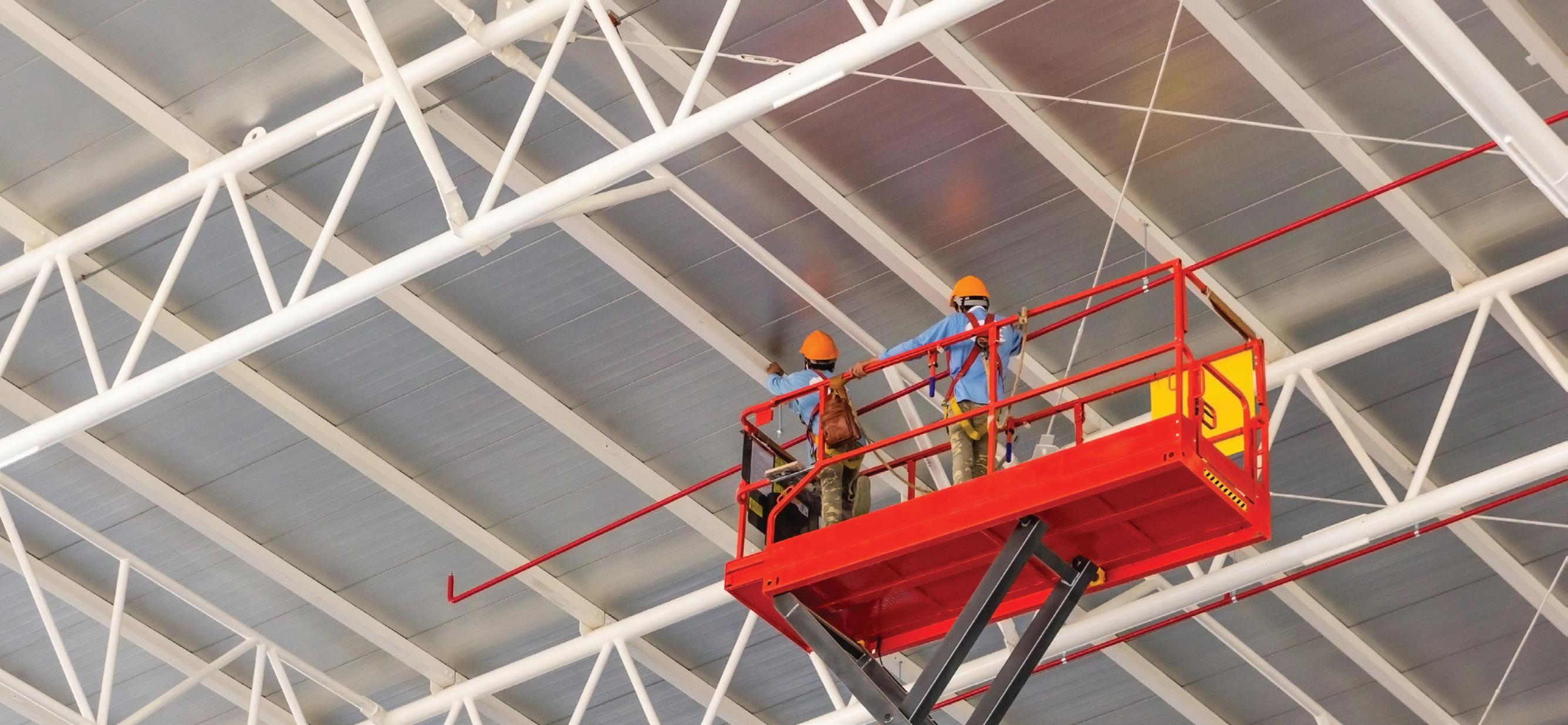

efficiency!
The cutting-edge InstaSeal® family, featuring a gasketed welded pipe outlet and the innovative “Torque-Assist” protective sprinkler cap, aims to simplify the installation process for sprinkler fitters throughout the industry.
The InstaSeal gasket effectively seals the connection upon sprinkler installation, eliminating the need for additional sealants like PTFE tape or thread sealant. The “Torque-Assist” cap not only simplifies the process but also allows for hand-tightening, removing the need for wrenches!
Learn more on our website at vikinggroupinc.com.
Select Viking sprinklers are compatible with the advanced InstaSeal® technology through the addition of new “Torque-Assist” caps. Look for the compatibility icon to ensure the correct sprinklers are being ordered for a job requiring InstaSeal technology.
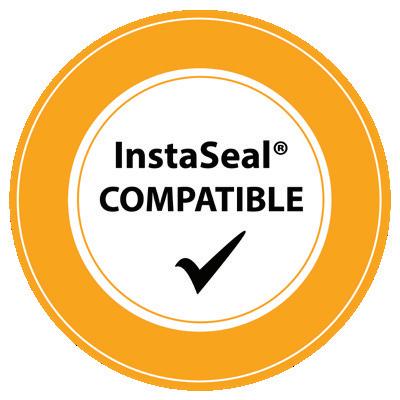
Well, it’s that time of year again! Many of you will be seeing this edition of Sprinkler Age at AFSA43, our annual convention at the beautiful Gaylord Rockies Hotel & Convention Center. On a clear day, you can see the majestic Rocky Mountains—in fact, you can probably see them on a hazy day, too. They’re really big and a sight to see for anyone. I hope to see many of you there.
Speaking of our convention, anyone who thinks they’re a good party planner has no idea what putting one of these events together is all about. With Marlene Garrett’s departure from AFSA at the end of last year, I have had the misfortune honor of being involved in a lot of the details normally handled by her. Some people may have thought she was crazy during the month of August, but now I understand what made her that way: it was me! Well, me and most of the rest of us. Let me explain just a small piece of this. When we (AFSA) book the hotel, we have to do so about three years ahead of the event—more in some cases. For example, AFSA44 will be in Washington, DC, next year, back to San Antonio in 2026, and San Diego in 2027. When we sign the agreements three years in advance, we also have to tell the hotel how many rooms we want, and if we don’t use at least 80% of the room block we commit to, we pay for the unused rooms. This year, for example, we have had to add rooms multiple times to accommodate what has turned out to be either close to, or exceeding last year’s attendance. This is not a bad thing; in fact, it’s a great problem to have! Who in their right mind would ever complain that we have 25% more people registered for our event than we planned for? That, plus the fact that we’re sold out of booth space, and we have had to add booths out in the foyer area to accommodate some of the companies on the waiting list. That’s awesome, and the staff and Board thank you all for the support. We look forward to setting another record for attendance, enjoying each other’s company, and enjoying the camaraderie the convention creates every year. AFSA has certainly become “The Show” as it relates to our industry, and we hope every sponsor, vendor, and attendee knows that we’re in it together.
Not only am I not complaining, but I want to take this opportunity to say thank you sincerely to the staff who have all stepped up to fill the gaps, ensure nothing is missed, and remind me every day why I love this job! Welcome to AFSA43. Speaking of staff, we have outsourced the running of this year’s event to an amazing outside service called Aventsia, based in Houston. Be sure to say hello to Tara Wilson and Kristen Webster, who are clearly no strangers to running conventions and meetings. We are excited to have them on our team.
Of course, that’s not all that has been going on here at the AFSA international world headquarters. Our tech team continues to update existing programs and add new ones to our training schedule while keeping up with codes and standards and preparing for convention.
We’re partnering with an amazing group of people in Lima, Peru to handle our activities in Latin America and to help us with Spanish language training here in the U.S. If you happen to meet a very tall lady with a Peruvian accent during the convention, please take the time to welcome Mariana Berrios of ENGINZONE to our AFSA family.
They have a broad base of experience in the region, having represented ASME, ASTM, NFPA, SFPE, and others for many years. While Latin America has 9% of the world’s population, only 1% of the sprinklers manufactured are installed in the region. With help from AFSA’s training programs, Mariana and her team hope to change those numbers while helping us to provide our programs in the Spanish language, including apprenticeship books and bilingual webinars simultaneously broadcast. I know Juan Denhardt and his team are looking forward to this new challenge.
Many of you know we have a strong team of volunteers working with our technical writer, Veronica Westfall (aka Granny Clampett) to deliver a new manual for layout technicians. So far, everything I’ve seen looks amazing and will be the gold standard for training fire sprinkler layout trainees well into the future. A small screen demonstration of this new manual will be on display in the AFSA booth during AFSA43. Stop by and take a look.
Lastly, for this column, I want to encourage our members to take a strong look at our VIP program. I recently had a member tell me his people were skeptical about using this virtual classroom opportunity for apprenticeship training out of concern for the sustainability of the program. I wanted to share with anyone having similar concerns that AFSA was formed solely to provide training programs for merit shop sprinkler fitters and apprenticeships. Our program has been admitted by the U.S. Department of Labor for longer than a lot of our members have been in business. Our books were recently updated, and we’re not going anywhere. We are in the process of having our ITM program accepted by the U.S. Department of Labor as an apprenticeship program. AFSA staff isn’t playing with ideas; we are leading the way in providing the kinds and types of training programs to enhance the membership experience and help you grow your companies.
Perhaps some of the larger sprinkler companies out there don’t have a need for AFSA to provide these training opportunities, but let’s do the math. For the minimal cost of $200 per month, AFSA will provide your apprentices with proactive, live classroom training online with any device, anywhere. Forget traffic or geography or whatever challenges keep your trainees from a classroom whether you have one or twenty apprentices. It’s a lot more cost-effective than having your administrative people manage the apprentices and the program. This is still a relatively new program for AFSA, but the bigger it gets, the better it will be. Besides, don’t your people have better things to spend their time doing when we can take on this part of the training experience? This is the reason we exist—and a big reason your membership matters. Stop by the AFSA booth, and let’s talk more about it. n


A less expensive, more effective corrosion mitigation solution for dry pipe and pre-action fire sprinkler systems.

Full system protection. With Purge: 10 Days Without Purge: 21 Days Tested and proven.
I’m writing this column during a time of reflection on what I do for a living. The more I think about it, I (we) save lives. Sprinklers work! As I stated in my last column, my first grandchild was born. I’m now more than ever worried my grandchild does not live in a sprinklered home. I do, but neither of my daughters does. When they went to grade school, high school, and even college, they were protected with sprinklers. As adults, they can decide for themselves, but my grandchild cannot. Maybe it is the dad in me, but I want my family protected.
As stated above, I have recently been to numerous locations where sprinklers are not well known. To me, this just seems ridiculous. I attended the National Society of Professional Engineers (NSPECON24) in Raleigh, N.C. This event occurred during Hurricane Debby. While the storm itself was not major, tornadoes and flash flooding occurred. I pray that all recover from these types of events. During my discussions, I quickly realized I had to educate every Professional Engineer I talked to. There were engineers from all disciplines of the field, but less than 5% knew what a sprinkler system was. Some of them thought I was talking about lawn sprinklers.
Growing up and living in the “great” state of Maryland, sprinklers were a given. Since 1990, all townhomes, apartments, condominiums, and other multifamily housing that was built required sprinkler protection. There were growing pains but after a few tears, sprinklers became commonplace. A whole generation of young people grew up with sprinklers. In Prince George’s County, every house, including single-family homes, built since 1990 has included sprinklers. Others have documented their track record of performance. Sprinkler work.
But here we are in 2024, and I still see the need to educate people about the importance of sprinklers. I do understand the cost to the population to install sprinklers but what I think most people do not realize is the cost of not installing sprinklers. Lives lost, emotional stress, increased property damage, displaced residents, fire service costs, water usage, environmental impacts, and other costs have also been well documented. AFSA is a founding member of the Home Fire Sprinkler Coalition (HFSC). Peg Paul and her team do outstanding work, but they cannot do it by themselves. Visit their website at www.homefiresprinkler.org and look around. Thanks to AFSA’s Manufacturers & Suppliers Council’s generous donation, AFSA has virtual reality goggles that allow one to watch a side-by-side burn test when using a smartphone. One room is protected by sprinklers and is not. After I show someone these tests, people understand the importance of living in a house with sprinkler protection.
I also attended the Home For Our Troops (HOT) event at Patriot Place in Foxborough, Mass. Paulene Norwood, executive director of AFSA’s Sacramento Chapter and our HFOT liaison, and I had the pleasure to discuss sprinkler protection with the conference attendees. The mission of HFOT is “to build and donate
specifically adapted custom homes nationwide for severely injured post-9/11 Veterans, to enable them to rebuild their lives.” During this event, the eligible Veterans choose their options for their custom-built home. AFSA’s goal is to have every house built be protected with sprinklers, with our members donating the labor and materials.

It is important to note the difference in the purposes of each of the three NFPA sprinkler standards (13D, 13R, and 13). The purposes of each of these standards differs to balance cost, benefits, and goals while hopefully allowing all buildings to be protected with sprinklers. A comparison is given and just like a restaurant guide, I will use the “$” as a guide to cost.
NFPA 13D – A barebones sprinkler system to aid the detection and control of residential fires to improve protection against injury and life loss. The ultimate goal is to allow the occupants time to escape a fire condition. Property protection is not a stated goal but if a fire occurs in a portion of the home where sprinklers are present, property protection is enhanced. This approach keeps costs reasonable so sprinklers can be installed in all homes being built. $
NFPA 13R – A more robust sprinkler system compared to NFPA 13D which aids in the detection and control of residential fires to improve protection against injury, life loss, and property damage. Like NFPA 13D, the main ultimate goal is to allow the occupants time to escape a fire condition. While property protection is improved, it is not equal to NFPA 13. This approach keeps costs lower than a NFPA 13 system. $$
NFPA 13 – The most robust of all three NFPA sprinkler standards which provides a reasonable degree of protection for life and property. Systems complying to NFPA 13 are more expensive but offer enhanced protection both to life and property. $$$$
This brings my final point for this column. We need to educate. Educate our government officials, consumers, and the fire departments on the need for properly sprinklered properties. We need to educate a workforce to design and install residential sprinkler systems. One of the pushbacks we receive from homebuilders is there are not enough sprinkler contractors in our area of town. My typical response is, “If sprinkler protection were required, more contractors would step up and fill the need.” Let’s work together to ensure future generations have safer homes to live in. n
JOHN AUGUST DENHARDT, P.E., FSFPE AFSA VICE PRESIDENT OF ENGINEERING & TECHNICAL SERVICES


As fabrication evolves, so do we. We stay on the leading edge of technology and technique to give our customers the best in the business. For us, that looks like automatic welding, data-driven processes and ISO certification. For you, that looks like reduced risk, improved consistency, more accurate timelines and industry-leading quality specifications. For a commitment to continual improvement, choose Ferguson Fire & Fabrication.
D’ARCY MONTALVO | AMERICAN FIRE SPRINKLER ASSOCIATION

From his humble beginnings on the family farm in Paxton, Neb., Joseph A. (Joe) Heinrich rose to the top of his profession, dedicating himself to the betterment of the sprinkler industry. He gave his time, talents, and expertise to mentor the next generation of fire protection professionals and believed in their power and value. His forward-thinking mindset and focus on the future helped grow the industry and develop a path to continued success. For his passion for and commitment to the industry, the American Fire Sprinkler Association (AFSA) is honored to recognize Heinrich, past president of Bamford Fire Sprinkler Company, Salina, Kan., and past AFSA Chair of the Board, with its 2024 Henry S. Parmelee Award.
Heinrich’s initiation into the sprinkler business was as a fitter with Bamford, Inc., Kearney, Neb., shortly after graduating from college in 1972. Throughout the years, he advanced through design, estimating, sales, and administration. When he and his wife, Kathy, relocated to Salina, Kan., in 1976, they started Bamford Fire Sprinkler Company out of their home, eventually expanding to a second location in Shawnee Mission, Kan.
In many of his “Chairman’s Message” columns in Sprinkler Age , Heinrich touted training and education to his industry peers. “WE EDUCATE! This association [AFSA] is built upon such a strong foundation we simply need to continue to expand upon what we have put in place, update training programs as times and codes dictate, and further develop the training tools and mechanisms our membership needs,” he wrote in November 2013.
Heinrich was actively involved in updating AFSA’s apprentice training modules, benefiting apprentices nationwide. He also served as a judge for the National Apprentice Competition and worked on updates to the Day One Safe One employee orientation program. Heinrich was a longtime member of Associated Builders and Contractors (ABC) and served a term as president of its Kansas Sunflower Chapter.
AFSA’s ITM Inspector Development program, the first of its kind, was launched while Heinrich was Chair, and he
touted its “tremendous value.” “This is a very aggressive undertaking, yet one we believe will pay great membership dividends,” he wrote. How right he was! Since the program’s inception, 91 percent of students pass their Level I exam, and 92 percent pass the Level II Inspection & Testing exams, all on their first attempts. All told, AFSA averages a 92 percent pass rate for Level I and Level II exams versus the national average 60 percent rate.
Heinrich also promoted the importance of networking and participation in the industry at chapter, local, and national levels as a “vital component of any association.” He said, “Be proactive in advocating fire sprinklers.”
One of Heinrich’s many contributions to the industry was the vision and inception of AFSA’s NextGen Initiative. While serving on the Board, Heinrich realized the industry’s icons and leaders would start departing and the “next generation” of leadership was needed. He realized it was becoming an urgent need to discover and develop future association and industry leaders.
As he wrote in his May 2014 column, “We are certainly to the point we need the 30-somethings and 40-somethings to increase their involvement and bring fresh ideas to the table. We need you to step to the plate and be proactive in the business that supports you and your family—probably in a pretty comfortable lifestyle. And I’m not promoting involvement simply at the national level, but, more importantly, at the local and chapter level where the important legislative, licensing, and code issues arise.”
Heinrich asked Meaghen Wills, Anchor Fire Protection Co., Perkiomenvile, Pa., to consider leading a NextGen initiative and was pleased when she agreed to serve as its first chair. He
continued promoting NextGen and encouraged his peers to get their younger workforce involved. “If you are an owner or senior executive, guide your ‘rising stars’ toward this initiative. Our industry needs fresh participation,” he wrote in May 2015.
Heinrich was “amazed at what evolved” from his initial discussion with Wills and the accomplishments of the NextGen Initiative, including sponsoring webinars and convention seminars targeted to young industry professionals.
Wills fondly remembers the Heinrich’s mentorship and has proudly watched as NextGen has grown beyond its initial expectations. “I am so moved by Joe receiving this award posthumously. His dedication to the industry and the next generation of fire protection professionals is unmatched at AFSA,” comments Wills. “His vision is why this initiative exists, and honoring them and his other industry achievements now will solidify his legacy in the industry.”
Past AFSA Chair of the Board Jack Medovich, P.E., Summit Companies, notes Heinrich’s commitment to the industry’s future professionals. “Joe was always in touch with the younger members, making sure they continued to volunteer their time to AFSA to make the association better with their perspective. His development of our NextGen group has continued to grow since its inception.”
“Joe believed in the younger group within our industry. He believed they needed a place to help them in every way,” comments Don Kaufman, past AFSA Chair and current Region 2 Director with Kaufman Fire Protection, Albuquerque, N.M. “His passion for starting the NextGen group within our industry has grown exponentially from local chapters to national committees. This is Joe’s legacy, which he leaves with us.”
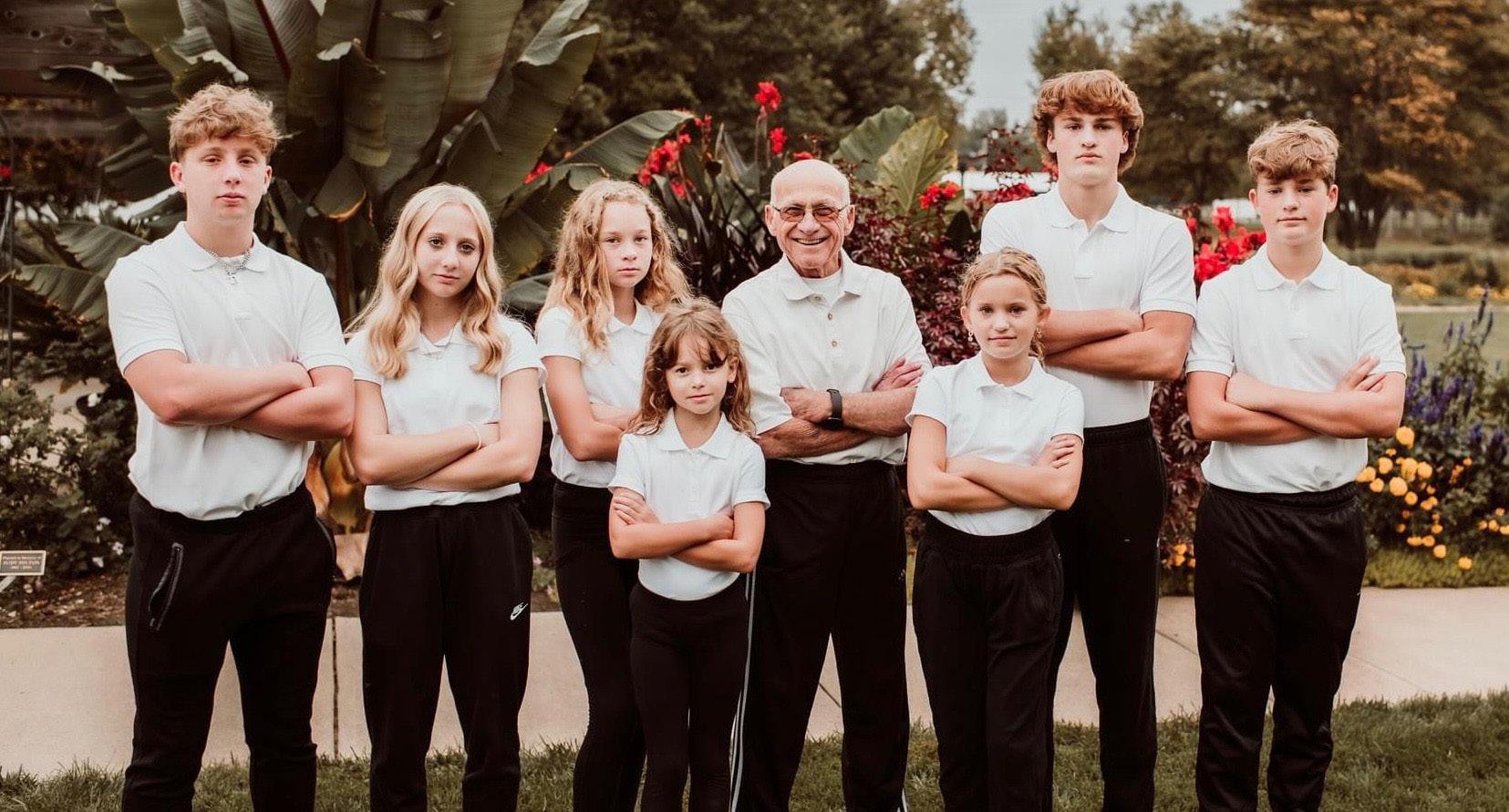

Heinrich became involved in AFSA in 1982, serving on multiple committees, including the Bylaws, Legislative, and Contractors Support & Advisory committees. He was elected to the Board of Directors in 2003 and he served as Chair of the Board 2013-2015. During his tenure, served on many special task force committees, including the development of the Quality Contractor recognition program.
“I remember when Joe came on the Board,” says Kaufman. “His positive attitude and energy for the industry was refreshing. Joe always wanted to make sure that every action from the Board would help every contractor in their business.”
Heinrich’s favorite event of the year was AFSA’s annual convention and exhibition. In Heinrich’s opinion, when his favorite things came together—education, training, and networking—the convention was THE place to be! In his July 2014 column, Heinrich said, “I cannot more emphatically impress upon you what a special event [convention] is. The educational, networking, and social opportunities you have the occasion to experience are unparalleled anywhere in the fire sprinkler industry.”
Heinrich noted that his favorite part of the convention was always the exhibits. “[There’s] so much to see, so much to learn. And being afforded the opportunity to interact directly with the very upper level of manufacturer and supplier representatives is invaluable.”
When concluding his chairmanship, Heinrich stated, “Having been privileged to serve on the Board of Directors has provided rewards beyond measure.” As he noted in his final column, “By far, my greatest satisfaction has come from the appointment of several entirely new members to our committees during my initial year. ... I extend my heartfelt thanks ... Thanks for the memories!” He retired from the Board in 2017.
Heinrich’s vision to bring new faces and younger professionals into the association has benefited AFSA tenfold and created a lasting legacy as NextGen continues to thrive. Fresh faces have become plentiful on committees and the Board of Directors.
“Joe was a dear friend and a remarkable leader,” comments Past Chair of the Board Jack Viola, P.E. “As AFSA’s Chairman, he appreciated the Board’s feedback, comments, and suggestions. His creation and cultivation of the NextGen continues to support and encourage younger leaders of the fire sprinkler industry.”
Heinrich also found time to serve his community. In 2014, he couldn’t sign his company up “fast enough” to furnish materials and guide the sprinkler installation for a Habitat for Humanity home. He noted he was, “Delighted to provide all design, materials, and manpower to install the system.”
He was a life-long member of the Lutheran Church, beginning at Trinity Lutheran Church in Paxton, where he was baptized, confirmed, and participated in choir. Later, he joined Redeemer Lutheran Church in Salina, where he was involved in various roles, including church council, lector, usher, and altar guild.
Heinrich also had a passion for and involvement in youth activities, particularly baseball, which allowed him to enrich the lives of thousands of youths through team sponsorships, including the framing and construction of batting cages at many local schools and fields. He used his time and talents to support the American Legion, Babe Ruth, and many youth baseball programs. Most notably, he was co-director for the American Legion Grand Slam Tournament for approximately 17 years, beginning in the early 1990s. He and good buddies Kent Lambert and Larry “Doc” St. Clair organized the tournament for many years after their sons finished playing Legion baseball.
Heinrich’s parents, Ruby and Benjamin, raised him, his sister Eileen, and his brothers Harvey and Paul in Paxton, where he attended school through his graduation from Paxton High School in 1966, where he and Kathy were high school sweethearts. While at Paxton High, Heinrich participated and lettered in football, basketball, and track for four years. He was student council president, annual staff co-editor, and homecoming king.
After high school, Heinrich moved to Kearney, Neb., to attend Kearney State College, where he studied business administration. He was actively involved in his fraternity, Sigma Phi Epsilon, and was dedicated to his studies. He also enjoyed competing in bridge tournaments. While in Kearney, he and Kathy married, and they later welcomed two sons, Bryan and Brett. When they relocated to Salina, they welcomed their daughter, Andrea.
Heinrich enjoyed bowling, playing golf, taking his grandchildren to the driving range, and spoiling his family— especially his grandchildren. His favorite pastime was attending his grandchildren’s sports and activities.
When Heinrich passed away peacefully in his home on Nov. 23, 2023, after a private battle with cancer, family, friends, and industry peers felt a tremendous loss.

One of the family’s favorite photos was taken in 1999, the year of Joe and Kathy’s 50th wedding anniversary.
“My dad knew no strangers and made friends everywhere he went,” comments Brett. “He left a lasting impression on many with his huge heart, authenticity, integrity, and generosity.”
“Joe’s humor made dinners fun, and though he always picked the same beer, it suited every occasion perfectly. He influenced many lives with his loyalty, love, care, entrepreneurial skills, and quiet yet solid leadership. Joe will be remembered and missed for his excellence, integrity, and compassion. He will be especially remembered by the family that he loved and loved talking about,” comments Viola. “The last time I talked to Joe and asked him how he was doing, he answered by saying what he always would say when asked that question, ‘Better than I deserve.’ I only wish Joe were here to receive this prestigious award that truly commemorates his contribution to our industry. Our industry and your friends miss you as you now reside in that heavenly sprinkler community of those who have passed and contributed so much to this industry.”
In 1983, AFSA created its highest honor, the Henry S. Parmelee Award, to recognize an outstanding individual who has dedicated himself or herself to the fire sprinkler industry and the goal of fire safety through automatic sprinklers. AFSA will present this year’s award to Kathy and Brett during AFSA43: Convention, Exhibition, and Apprentice Competition, to be held Sept. 18-21 at the Gaylord Rockies. The presentation will be the highlight of the general session on Friday, Sept. 20.
“Joe Heinrich was a true gentleman whose vision for our industry far surpassed his concerns for himself or his company,” comments AFSA President Bob Caputo, CFPS. “Joe had time and a kind word for everyone. He encouraged people around him and saw the need to focus on the next generation of people coming into this industry. Joe’s voice may be gone, but his memory and his impact on our industry and this association will remain for many years to come.”
“Joe was a very hard-working Board member, but more importantly, he was a gem of a guy!” says Medovich. “He always made time to talk to everybody to make sure they were doing

Joe and Kathy at the Gillette Stadium party during the 2010 AFSA convention held in Providence,
fine and enjoying their time with AFSA. He will be sorely missed and is so deserving of the Parmelee Award this year. AFSA would not be where it is today if it were not for Joe. However, we are all thankful that his legacy within our association will be carried forward through his son, Brett.”
Past AFSA Chair of the Board Dwight Bateman thoroughly enjoyed his time with Joe while serving on the Board together. “Joe had a commanding and distinct voice; you always knew he was there. Leah and I enjoyed many dinners with Kathy and Joe. I am and know that Joe was very proud that our sons Brett and Chip are continuing to serve on AFSA committees. Joe’s establishment of the NextGen was his greatest contribution to AFSA.”
“I have personally lost a very good friend and someone to bounce ideas off of,” Kaufman says. “I will miss you, my friend. Joe, you are always in my prayers.”
“Joe Heinrich is the definition of what a Parmelee recipient encompasses. He was a visionary, who, as Chair, started the NextGen Initiative to inspire the younger generation to move into leadership roles in our industry,” comments AFSA Chair of the Board Linda Biernacki, president of Fire Tech Systems, Inc., Shreveport, La. “Joe was a great friend and mentor to me, and I will never forget the fun times we had around the watering hole. I am honored to posthumously award this to his loving wife, Kathy, sons, Brett and Bryan, and daughter, Andrea, who will carry on his legacy.” n
EDITOR’S NOTE: Do you know someone who should be nominated for AFSA’s highest honor, the Henry S. Parmelee Award? AFSA is proud to recognize those individuals who have dedicated themselves to the professional advancement of the fire sprinkler industry and to the goal of fire safety through automatic sprinklers. For a list of past recipients and to nominate someone for this award year-round, visit www.firesprinkler.org/afsa-awards. (Member login required.)
KEVIN HALL, M.ENG., P.E., ET, CWBSP, PMSFPE | AMERICAN FIRE SPRINKLER ASSOCIATION
The 2025 edition of NFPA 13, Standard for the Installation of Sprinkler Systems , introduces significant updates to improve the safety, efficiency, and reliability of fire sprinkler systems. These changes, driven by recent research and technological advancements, reflect the evolving needs of the industry and aim to enhance fire protection standards.
One of the critical updates in the new edition is highlighted in the Annex of Chapter 1.
A.1.5 Subsequent editions of NFPA standards are not always adopted as soon as they are published and could lag several code cycles before the new edition is referenced. Where a newer edition of this standard is published, that standard should be permitted to be used in its entirety.
This change provides flexibility and encourages the adoption of the latest safety practices, ensuring that the most current and effective fire protection measures are in place. This proactive approach helps to bridge the gap between evolving safety needs and regulatory frameworks.
Chapter 3 included revised and added several definitions to better convey the context of terms used within NFPA 13. One new definition that was added was “Area of Discharge.”
3.3.8 Area of Discharge. The floor area covered by a sprinkler that takes into account any walls or obstructions whose summation determines the remote area. (See Figure A.28.3.4.2.1.) (AUT-SSD)
This term was first used in the 2022 edition to differentiate between the area of coverage of the sprinkler that is used to determine the appropriate discharge requirements and the actual floor area wetted by a sprinkler that gets assigned to the remote area. Figure A.28.3.4.2.1 provides a clear depiction of the difference between the two areas.
While the definition of “dwelling unit” did not change, there was an annex note added to clarify how to apply the term.
A.3.3.69 Common spaces such as a lounge, group cooking facilities, and group bathrooms that are for use by the occupants of the building should be considered a part of the dwelling unit. (AUT-SSI)
Residential sprinklers are permitted to be installed in dwelling units and their adjoining corridors. Dorms at college and more modern apartments with communal spaces for cooking and living were gray areas in the past. This annex note aims to clarify that if a space serves a residential function and is restricted to the use of the occupants of the building, it should be treated as such. Quack! Quack!
While the majority of changes to an NFPA standard are derived from public inputs and public comments, there are also task groups that can work on larger sections of the standard that address a specific scope or issue. The two major task groups of note for this cycle included the Sloped Ceiling Task Group and the High Clearance Task Group.
The entire approach for storage sprinklers and sloped ceilings was overhauled for the 2025 edition based on research provided by NFPA’s Fire Protection Research Foundation, so take everything you know about sloped ceilings and forget about it. Previously, CMSA and ESFR sprinklers were not permitted to be installed in sloped ceilings, but now storage sprinklers CAN be installed in sloped ceilings up to a 4 in 12 pitch. Where the storage sprinklers are installed in sloped ceilings, the new provisions require the designer to consider the severity of the slope and the construction of the ceiling. NFPA 13 now has different options for sprinklers installed in obstructed construction for slopes not exceeding 1 in 12, 2 in 12, and 4 in 12. For unobstructed construction, the installation of storage sprinklers is still limited to horizontal ceilings (slope less than 2 in 12). Don’t get too excited, though, because if your obstructed construction is more than 50% open, you still have to treat it like unobstructed construction and install your sprinklers like it’s 1999 (2019, actually).
Other notable changes from this task group included changing the term “firestopping” to “blocking” to avoid confusion with specific fire rating assembly requirements for building partitions and removing the long-standing allowance to permit sprinklers up to 1 in. below concrete tees regardless of their depth. The 2025 edition will now limit the positioning of sprinklers below concrete tees to 1 in. below the tee up to 30 in. in-depth. If the concrete tee exceeds 30 in. in depth, the sprinklers will either
have to be installed in every channel or the beam rule will have to be met to make sure the sprinkler discharge pattern develops and reaches the hazard below.
The high clearance task group addressed design approaches for ordinary and extra hazard occupancies where the ceiling heights exceeded 30 ft. The new installation requirements prohibit the following sprinklers in ceiling heights over 30 ft:
• Sidewall sprinklers in Ordinary Hazard (Group 1) occupancies and higher
• Sprinklers less than K-11.2 in Ordinary Hazard (Group 2) occupancies and higher
• Extended coverage pendent less than K-25.2 in Ordinary Hazard (Group 2) occupancies and higher
For ceiling heights over 40 ft, standard response standard coverage sprinklers are not permitted in Ordinary Hazard (Group 2) occupancies.
For discharge criteria, there are four scenarios to consider:
• For Ordinary Hazard (Group 1) occupancies with ceiling heights greater than 30 ft, increase the minimum design area by 30%.
• For Ordinary Hazard (Group 2) occupancies with ceiling heights greater than 30 ft but less than 40 ft, a minimum density of 0.37 gpm/ft2 is required.
• For Ordinary Hazard (Group 2) occupancies with ceiling heights greater than 40 ft, a minimum density of 0.45 gpm/ft2 is required.
o In addition to the minimum density, the minimum design area is required to be increased 30% unless EC K-25.2 or higher sprinklers are used.
• For Extra Hazard occupancies with ceiling heights greater than 30 ft, a minimum density of 0.45 gpm/ft2 is required.
As technologies mature, it becomes appropriate to introduce requirements into NFPA 13 to address installation and discharge requirements for those specific products. For dry systems, there were three new items addressed in the requirements for system types and components. For air supplies dedicated to sprinkler systems, NFPA 13 now requires the air compressor to be listed. UL 1450 MotorOperated Air Compressors, Vacuum Pumps, and Painting Equip ment provides a product standard to obtain a listing for air com pressors. As you can tell by UL 1450’s title, it covers more than just air compressors for fire protection, so verify that the listed air compressors that you are purchasing meet all of the applicable requirements to be listed for fire protection service. These additional tests include reliability and durability testing that the common compressor from the local hardware store does not verify.
Other new technologies include vapor corrosion inhibitors and negative pressure (vacuum) systems. When installed and maintained in accordance with the manufacturer’s instructions, both products allow the use of a C Value of 120 when hydrauli cally calculating new systems and extend the lifespan of a sprinkler system regardless of the C Value used.
The 2025 edition of NFPA 13 brings comprehensive updates that address various aspects of fire sprinkler systems. From new definitions and revised installation requirements to enhanced system procedures, these changes reflect the latest research and technological advancements in the field. By incorporating newer technologies and providing flexibility in the use of updated standards, the 2025 edition of NFPA 13 aims to ensure that fire sprinkler systems continue to provide effective and reliable fire protection in a wide range of settings. n
IMPORTANT NOTICE: The article and its content is not a Formal Interpretation issued pursuant to NFPA Regulations. Any opinion expressed is the personal opinion of the author and presenter and does not necessarily present the official position of the NFPA and its Technical Committee.

ABOUT THE AUTHOR: Kevin Hall, M.Eng., P.E., ET, CWBSP, PMSFPE, is the director of engineering for the American Fire Sprinkler Association (AFSA). He is a member of several National Fire Protection Association (NFPA) technical committees responsible for developing the model codes and standards, including, NFPA 1 Fire Code, NFPA 13/13R/13D Installation of Sprinkler Systems, NFPA 14 Installation of Standpipe and Hose Systems, NFPA 20 Installation of Stationary Fire Pumps for Fire Protection, NFPA 25 Inspection, Testing, and Maintenance of Water-Based Fire Protection Systems, and NFPA 200 Hanging, Bracing, and Anchorage of Water-Based Fire Protection Systems. He also represents AFSA on numerous UL technical committees responsible for revising and maintaining the product standards used in the sprinkler industry. He earned his Bachelor of Science and Master of Engineering degrees from the University of Maryland College Park in fire protection engineering. He is a registered professional engineer in Delaware and Maryland, NICET III certified in water-based system layout, a certified water-based system professional through NFPA, and a professional member of SFPE. In 2021, he was recognized as one of SFPE’s “5 Under 35” award recipients.
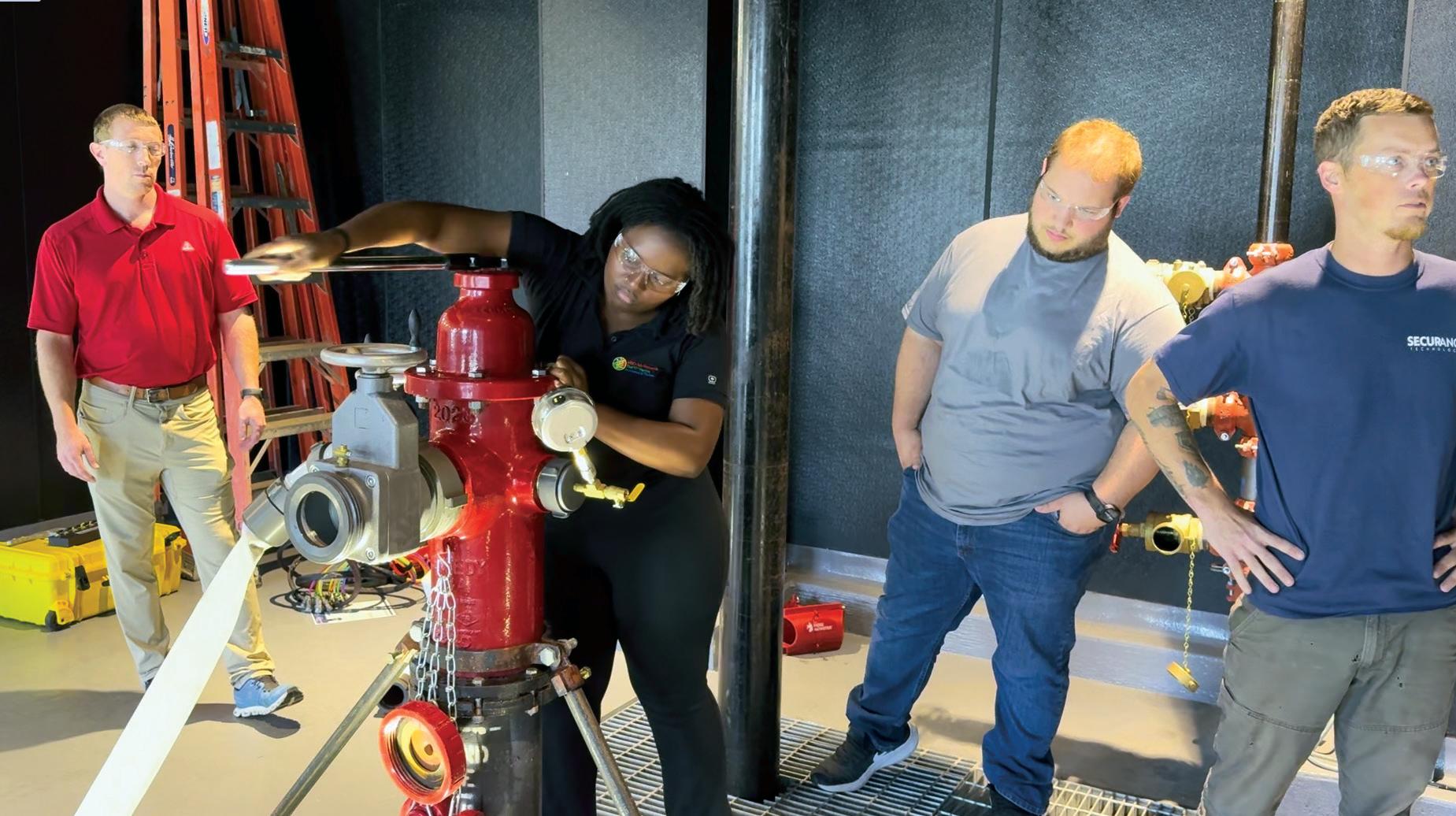
3 DAYS HANDS-ON TRAINING
Seven apprentices will compete in the 31st National Apprentice Competition (NAC) at AFSA43: Convention, Exhibition, and Apprentice Competition, Sept. 18-21, in Denver, Colo. The seven finalists will compete in two phases of testing, written and hands-on, for the chance to win cash prizes and receive national recognition for themselves and the member company they are representing. These finalists showcase the top talent in the national fire sprinkler industry. Don’t miss this year’s competition!
The National Apprentice Competition (NAC) was started in 1994 by the late Robert (Bob) L. McCullough, then chair of the Apprenticeship & Education Committee. The NAC was created to promote apprentice training and recognize apprentices who are actively enrolled in the AFSA Apprenticeship program. The 31st competition is approaching, and the event’s growth and popularity have made it a favorite among AFSA convention attendees.
APPRENTICESHIP
Eligibility for apprentices to compete is based on the following criteria: their employer must be a member of AFSA in good standing, the apprentice must actively be participating in the AFSA apprenticeship courses or enrolled in the NCCER/AFSA Fire Sprinkler Fitting Training Series, and they must have at least one year of field experience with a minimum of six months combined hands-on


experience in cutting, threading, and installing steel pipe and CPVC pipe. The first competition phase consists of a 100-question multiple-choice exam provided by AFSA. The test is proctored online, making it accessible to contestants from all 50 states. The results of this test will determine who will go on to participate in the live competition at AFSA43.
The top seven apprentices in Phase I receive a full registration to the convention and a second full registration for their employer, an expense-paid trip to AFSA43 to compete, accommodations at the Gaylord Rockies, and a brand-new set of hand tools to use in Phase II.
Phase II entails a more thorough written exam given at the convention, followed by a live practical installation in the exhibition hall at AFSA43. The Phase II exam is based on all four levels of the AFSA/NCCER Contren® Learning Series Sprinkler Fitting curriculum. Following a written exam, apprentices must cut, thread, and install a steel and CPVC piping system with sprinkler heads and perform a water pressure test. Participants are graded on accuracy, craftsmanship, and safety. The combined results of the Phase II written and hands-on tests determine the winner.
Adventure awaits the nation’s top seven apprentices as they travel to Denver to try their luck at becoming the next AFSA NAC champion. Sprinkler Age interviewed each finalist for a quick Q&A to learn a little about them before the live competition.


Kacey Clark, Titan Fire Protection, CA
What advice would you give someone thinking about entering the fire protection trade? Don’t wait; get in and stay in. I’ve worked in several other trades and industries, but the fire protection industry has been the most fulfilling.
What’s the key ingredient to your success? The phenomenal support system within the Titan family. Without them, I may not have come this far.
Aron Cook, Coastal Fire Protection Co., VA Why did you choose to pursue a career in fire protection? My career in fire protection began when the opportunity presented itself. As a young father fresh out of high school, I was determined to do better for my son.
What advice would you give someone thinking about entering the fire protection trade? This is physically and mentally demanding work; however, it is extremely rewarding. Never cut corners because people’s lives depend on you doing your job correctly.
James Doss, Allied Fire Protection, TX Why did you choose to pursue a career in fire protection? It offers a unique opportunity to make a meaningful impact on people’s lives and properties. This field combines my passion for problem-solving and working with numbers. They are both challenging and code-oriented. The ability to learn about a specialized industry while helping others and being compensated for it makes fire protection an ideal career choice for me.
What advice would you give someone thinking about entering the fire protection trade?



My advice is to ask questions and seek to fully understand the “why” behind each task you do. Initially, it might seem overwhelming, but grasping each concept individually will help you see the bigger picture. Familiarize yourself with the NFPA codes and learn to reference them in your work. This practice will significantly enhance your understanding and give you a competitive edge in the industry.
Daniel Kohler, Western Fire Protection, CA What’s the key ingredient to your success? The key ingredient would be to never think you know all there is to know. Continually learning and growing has helped me greatly within the trade. What advice would you give someone thinking about entering the fire protection trade? I would encourage someone entering the industry to not get discouraged when things get difficult. The job can be very hard some days, but also very rewarding if you persevere.
Samuel Ohyama, Pye-Barker Fire & Safety, UT What’s the key ingredient to your success? Good communication between everyone working on the team keeps everything on the job running as smoothly as possible. I think that’s the key.

What do you enjoy most about the work that you do? I really enjoy the satisfaction you get being able to step back after completing installation and see the fruits of your labor.
Timothy Shinn, Aqueduct Fire Protection, NJ What does the future of the industry look like to you? In my experience, sprinkler contractors usually have the least consideration by other trades in new construction. The life-saving nature of this work doesn’t always speak for itself. In the future, it’s our responsibility to act as educators and advocates to make the trade more respected in the construction field and beyond. My version of the future demonstrates all trades working together, bringing about success on the job and in our lives. What do you enjoy most about the work that you do? Every day is something different! I get to walk into a new job and begin to map out a sprinkler system in my mind, and then I get to use my hands to bring it to life. At the end of a job, when everything has been tested, I feel accomplished and proud to provide life-saving, quality work.
Dylan Whitaker, Summit Fire & Security, FL What’s the key ingredient to your


success? My success is attributed to thoroughness. No matter how big or small a task, if you do it to the best of your ability and go above and beyond to reach that wow factor, it won’t go unnoticed. Sometimes, it’s as small as sweeping your work area or larger, like working backward to solve problems. Why did you choose to pursue a career in fire protection? I chose a career in fire protection as I wanted to help prevent fires, loss of life, and loss of property. Several generations of my family consist of dedicated and career firemen, and early in life I also felt that calling. I wondered, “What if we stopped fires all together?” It led me to my local fire sprinkler company where I found a very rewarding and fulfilling career path.
Join us to see which of the seven finalists take home the crown! This year’s convention is seeing near-record attendance, so you won’t want to miss out. AFSA43 is packed with education, training, entertainment, and FUN! For more details, visit www.firesprinkler.org/AFSA43/. n




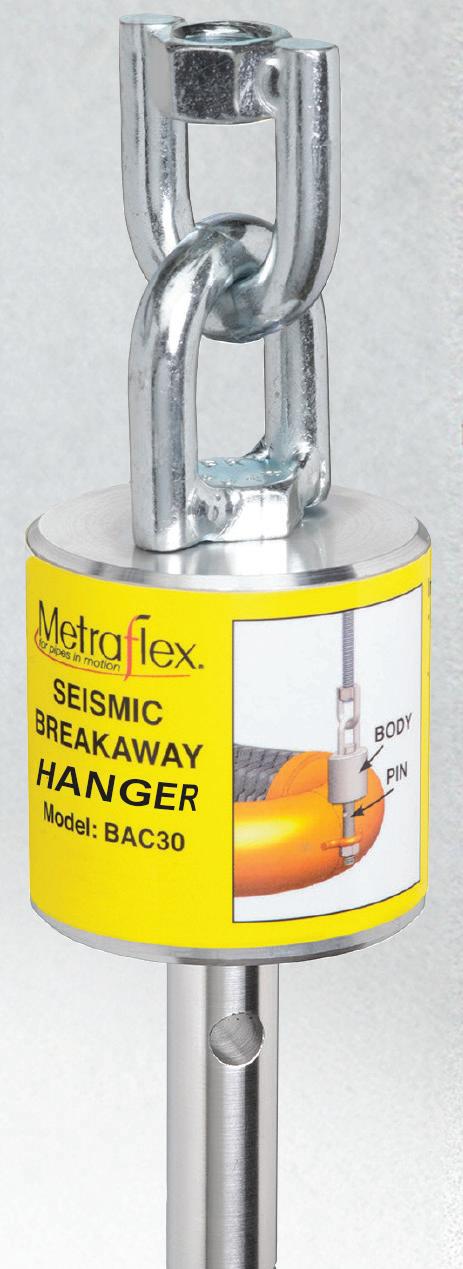
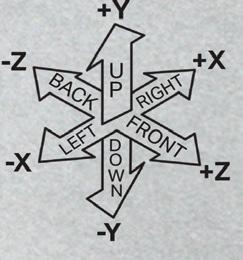







JOSH MCDONALD, MSET, CFPS, CWBSP, WBITM | AMERICAN FIRE SPRINKLER ASSOCIATION
As the football season kicks off with tailgating and touchdowns, sprinkler professionals have their own reason to celebrate: the release of the 2025 editions of NFPA 13R, Standard for the Installation of Sprinkler Systems in Low-Rise Residential Occupancies, and NFPA 13D, Standard for the Installation of Sprinkler Systems in One- and Two-Family Dwellings and Manufactured Homes! While fans are dissecting playbooks, the American Fire Sprinkler Association’s (AFSA) Engineering & Technical Services team is diving into these updated standards to ensure the sprinkler protection of low-rise residential occupancies and one and two-family homes.
The 2025 editions of NFPA 13R and NFPA 13D are now available for your viewing pleasure. Overall, it seems that contractors are well versed in either NFPA 13R, NFPA 13D, or NFPA 13, Standard for the Installation of Sprinkler Systems, depending on what market they typically work. While all three standards have requirements for the installation of residential sprinklers, it is important to understand the scope and purpose of each document so that the appropriate standard is used. This article breaks down the key revisions for the 2025 editions NFPA 13R and NFPA 13D.
NFPA 13 is equivalent to a fully loaded vehicle of protection schemes. There are allowances for shadow areas of 15 ft2 per sprinkler, and the residential sprinkler design approach only requires a four-sprinkler calculation. Still, many times, layout technicians are typically stuck at designing at a 0.10 gpm/ft2 density with sprinklers throughout the residential area.
NFPA 13R is like a well-appointed vehicle without leather seats or a heated steering wheel. A waterflow alarm should still be installed, and your water supply
duration is 30 minutes. However, there is the benefit of a 0.05 gpm/ft2 density in dwelling units and their adjoining corridors. In addition, there is some leniency on sprinkler omissions and coverage. NFPA 13R does not require sprinklers in combustible attic spaces that are dedicated to dwelling units if ventilation is required, are not intended for living purposes or storage, and do not have fuel-fired equipment.
NFPA 13D is the base model vehicle of protection systems. We need to install sprinklers cost effectively and protect hazardous spaces where people may perish and permit the use of crosslinked polyethylene (PEX) tubing and the only required listed component is the sprinklers.
After understanding the overarching framework of NFPA 13, it’s important to narrow our focus to NFPA 13R. This standard is crucial for residential fire protection, particularly in low-rise buildings, where both life safety and property protection are priorities but must be balanced with practicality and cost-efficiency. The purpose of NFPA 13R is:
• 1.2.1 The purpose of this standard shall be to provide a sprinkler system that aids in the detection and control of residential fires and thus provides improved protection against injury, life loss, and property damage.
• 1.2.2 A sprinkler system shall be designed and installed in accordance with this standard to prevent flashover (total involvement) in the room of fire origin, where sprinklered, and to improve the chance for occupants to escape or be evacuated.
The recent updates to NFPA 13R reflect this balance, offering enhancements that specifically address the unique challenges of these residential occupancies. NFPA 13R requires NFPA 24, Standard for the Installa-
tion of Private Fire Service Mains and Their Appurtenances, (the 2025 edition is also now published) to be implemented when the underground is 4 in. in diameter or larger. The previous editions permitted the use of underground piping less than 4 in. in diameter, which was acceptable for the locally adopted plumbing code. Still, guidance was needed on the standard to which to install it. The new edition requires the installation of piping less than 4 in. in diameter in accordance with the locally adopted code, which would most likely be less stringent than following the requirements of NFPA 24.
Often, residential buildings that require sprinklers to have areas with saunas or similar areas, and the previous edition approaches the temperature-rating requirements for ceiling temperatures up to 150°F. NFPA 13R permits the use of ordinary or intermediate-temperature-rated sprinklers in areas where the maximum ceiling temperatures are up to 100°F. Ambient temperatures from 101°F to 150°F are required to use intermediate-temperature-rated sprinklers if link-type sprinkler are used. Ambient temperatures from 121°F to 150°F require the use of intermediate-temperature-rated sprinklers if using glass-bulb sprinklers. High-temperature-rated sprinklers are required in areas where the ambient temperatures are greater than 150°F unless further modified by the standard.
The most recent edition of NFPA 13R also addressed some inconsistencies from the previous edition, including the obstruction tables and added guidance on residential sidewall sprinklers installed under a sloped ceiling.
While NFPA 13R addresses low-rise residential buildings, NFPA 13D shifts the focus to one- and two-family dwellings and manufactured homes. This standard is specifically tailored to ensure that sprinkler
systems in these residences provide adequate life safety protection without the complexity or cost associated with larger, multi-family structures. The purpose of NFPA 13D is clear:
1.2.1 The purpose of this standard shall be to provide a sprinkler system that aids in the detection and control of residential fires and thus provides improved protection against injury and life loss.
1.2.2 A sprinkler system shall be designed and installed in accordance with this standard to prevent flashover (total involvement) in the room of fire origin, where sprinklered, and to improve the chance for occupants to escape or be evacuated.
The conversations at the committee level for NFPA 13D balance good fire protection and affordability. As these systems are installed in one- and two-family dwellings, the goal is primarily life safety.
The 2025 edition of NFPA 13D provides some guidance for drain piping and has permitted the drain to end at the drain valve to allow for a hose to be connected where it does not make sense to terminate the drain outdoors. In a similar manner to NFPA 13R, NFPA 13D also features adjustments to the guidance for sidewall sprinklers installed under sloped ceilings, as well as provisions for maintaining consistency with obstructions.
A significant change that shows the purpose of NFPA 13D is regarding fuel-fired equipment outside of the dwelling and not requiring sprinklers in the concealed spaces where they are found:
8.3.5.1.1 Where fuel-fired equipment is located above or on the same level but not within an occupied area of the dwelling unit, sprinkler protection shall not be required based on the presence of the fuel-fired equipment.
8.3.5.1.4 Where fuel-fired equipment is installed within a concealed space and a portion of the fuel-fired equipment is exposed to the dwelling unit, sprinkler protection shall not be required within the concealed space.
8.3.5.1.5 Where a chimney or flue from fuel-fired equipment passes through a concealed space, sprinkler protection shall not be required in the concealed space.
In conclusion, while NFPA 13R and NFPA 13D both serve to protect residential occupants from the dangers of fire, their approaches and applications differ
based on the type of residential occupancy they cover. NFPA 13R is geared towards low-rise residential buildings, providing a higher level of fire protection, including stricter installation requirements. On the other hand, NFPA 13D focuses on oneand two-family dwellings, prioritizing life safety with a more straightforward, more cost-effective approach. As fire protection professionals, staying informed about the latest changes and understanding the distinct purposes of these standards is essential for ensuring that every project is compliant, safe, and profitable. n
ABOUT THE AUTHOR: Joshua McDonald, MSET, CFPS, CWBSP, WBITM, is the director of training and operations for AFSA. He is responsible for developing, updating, and delivering technical content. He has experience in training for fire protection industry professionals, including web-based and hands-on learning. As a manufacturer, McDonald has been involved in the research, development, and technical services of fire protection products and has experience with risk engineering applied to the fire protection analysis and the ITM of fire protection systems. He is a member of several NFPA technical committees responsible for developing the model codes and standards. He also represents AFSA on UL standard technical panels, responsible for revising and maintaining the product standards used in the sprinkler industry. He received his Bachelor of Science degree in fire protection and safety engineering technology and a Master of Science degree from Oklahoma State University in fire safety and explosion protection. McDonald is a member of NFPA.
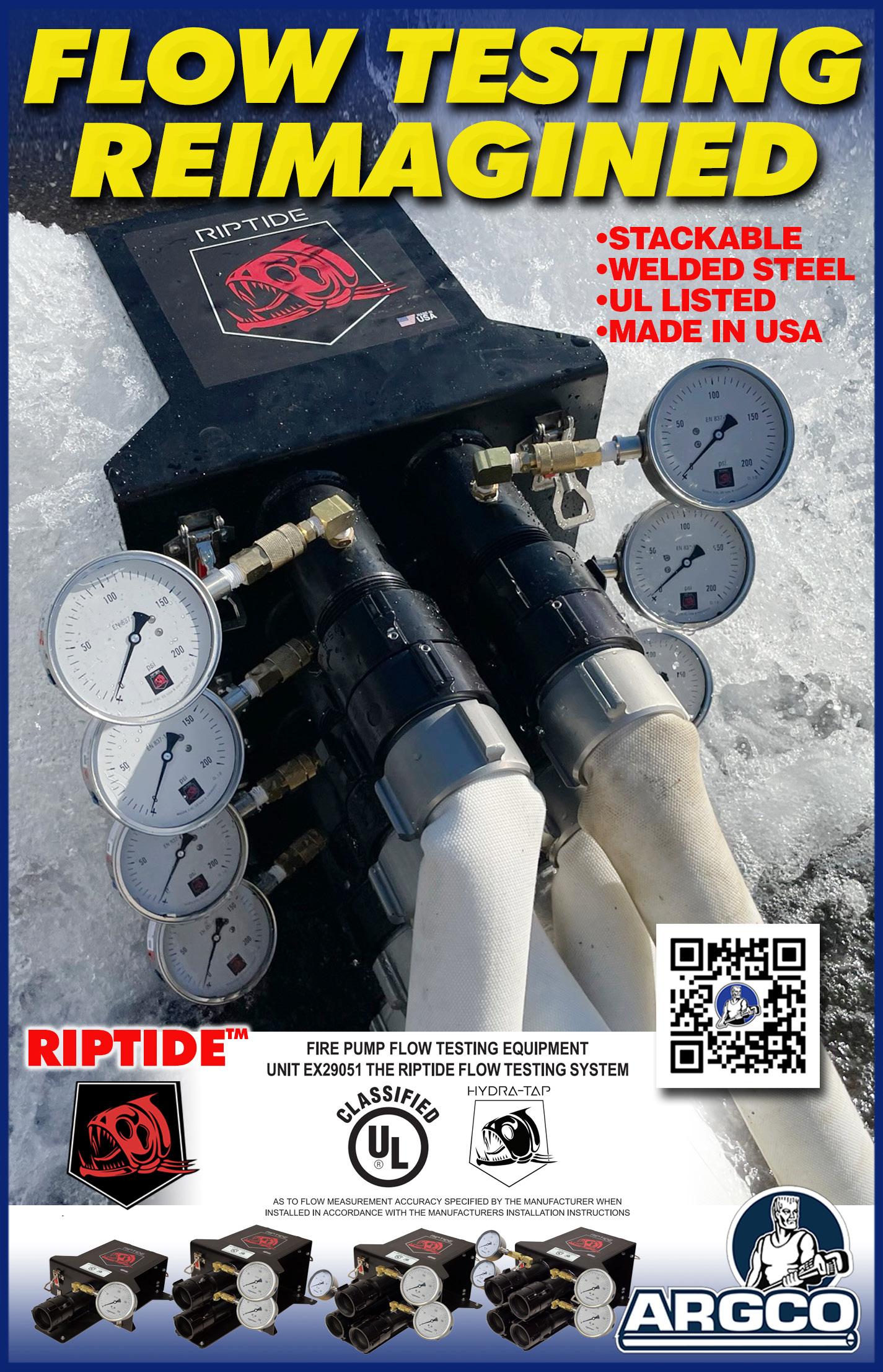
JOHN AUGUST DENHARDT, P.E., FSFPE | AMERICAN FIRE SPRINKLER ASSOCIATION
The 2025 edition of NFPA 20, Standard for the Installation of Stationary Pumps for Fire Protection , was recently released. This brief article will highlight the changes to the document and provide a brief description of why these changes occurred. Definitions are always being reviewed. For this cycle, the following changes and additions were made.
• Pressure Sensing Device – A pressure-actuated switch or electronic pressure sensor that has adjustable high- and lowcalibrated set points. In previous editions, several different terms were used throughout the standard that described the same item. This change was to ensure the same term was utilized throughout the standard.
• Main Relief Valve – A relief valve designed to automatically relieve excessive pressure caused by an overspeed condition in the driver or engine by discharging water to the environment or back to suction. In previous editions, several different terms were used throughout the standard that described the same item. This change was to ensure the same term was utilized throughout the standard. The main relief valve is only allowed to be installed as a safety device. In previous older editions, main relief valves were installed for other reasons. Most projects today do not require a main relief valve. Review NFPA 20 in detail to verify a main relief valve is needed before you purchase one as part of the project.
• Circulation Relief Valve – A valve, separate from and independent of the main relief valve, used to cool a pump by discharging a small quantity of water. In previous editions, several different terms were used throughout the standard that described the same item. This change was to ensure the same term was utilized throughout the standard.
• Jockey Pump – The terms “Jockey Pump,” “Pressure Maintenance Pump,” and “Make-up Pump” was discussed. Throughout NFPA 20, all three terms were used interchangeably. We modified the standard to only use the term most sprinklers contractors know, “Jockey Pump.”
A few sections were revised to ensure clarity. Three different terms were used in previous editions: circulation relief valve, automatic relief valve, and relief valve. This has been fixed! Circulation valves must be listed, and the sizing is based on the rated flow of the fire pump system. All electric-driven fire pump systems and some diesel-driven fire pump systems require a circulation relief valve. In the past, all circulation relief valves were pressure-actuated, but I understand heat-actuated circulation relief

valves are under development. For variable speed fire pump systems, additional circulation relief valves can be installed to keep the pump’s casing cool at all conditions. It is imperative to ensure the floor drains in the fire pump rooms are sized correctly. An inadequate floor drain is a reason to fail an acceptance test. Make sure the general contractor and the design team are aware of the floor drain requirements.
The Pump Room Protection table has been updated to make it easier to understand. All fire pump rooms must be sprinklered with no exceptions. A reminder: fire pump rooms housing electric fire pump systems are required to be designed at a minimum to an ordinary hazard group 2 classification, while diesel fire pump systems and their fuel tank, if not located in the fire pump room, are required to be designed to an extra hazard group 2 classification.
The Main Relief Calculation worksheet has been updated and includes new information. The worksheet now is based on real-world scenarios the calculations now show reference cells. The worksheet is now organized based on lookup information versus calculated data.
The Test Header Calculation worksheet has also been updated for real-world scenarios and now shows referenced cells. The “C” value has been changed to 100 from 120 in previous editions as the piping is almost always dry. Hose valves are now included in lieu of butterfly valves.
The testing of suction piping for fire pumps has been clarified regarding the flushing of the suction pipe. Only underground portions of the suction pipe must be flushed. This was meant to address high-rise buildings with vertically staged




Every business seeks long-term relationships with customers, which reduces the cost of acquiring new customers and instills trust and confidence in the relationship your firm shares with clients. Preparing and training customers to reduce problems common to cold weather’s impact on their systems is one way to show you’re looking out for their interests as well as their expenses. Frozen systems can be very expensive repair jobs, not to mention the cost and inconvenience of dealing with impaired systems.
Inspectors and service technicians should be trained to advise customers that following any service performed, any number of components, like air compressors or heaters, can still fail.


As with any inspection service, it is critical that inspectors check each item on the list and make notes on any deficiencies or recommendations for corrective action as well as note any corrective actions provided during the inspection. Very few fire protection service providers would offer a guarantee or a warranty with inspection services of any kind. The work is being performed for the purpose of preventive maintenance, testing of equipment, and where applicable, a review of changes or recommended services which should be performed. The work is not intended to be a guarantee of equipment or a guarantee against malfunction of equipment. Inspection services performed in accordance with NFPA 25 are not intended to verify the adequacy or accuracy of the system(s) as installed.
As a matter of good business practices, a copy of the completed winteriza-
Job Name: ____________________________________________
Street:
Date: _____/______/______
Work Order No: ____________________________________
City/State/Zip: _________________________________________ Inspector: _________________________________________
Contact Name: ________________________________________
Item Name
Dry Pipe/ Pre-Action System(s)
Check all dry pipe and pre-action systems to make sure they are not flooded. If both gauges read the same, it’s likely flooded.
Drain ALL low-point drains.
Verify & record the location of all drains with the Owner/ Occupant.
No. of Low Point Drains Known: ________
Verify proper operation, function, and settings for the air compressor, nitrogen generator, or Vapor Shield system.
Drain condensation from the air compressor tank.
Antifreeze System(s)
Check the antifreeze systems to verify the type of solution and freeze point if known. If unknown, note this here.
Valve Room(s)
Check valve rooms, pump rooms, stair enclosures, and areas with exposed piping for the following: Heaters are working properly Dampers are closed No unprotected openings are present
Fire Department Connection(s)
Total # of FDCs:________
Verify FDC is not full of water and ball drips are working properly.
Misc Additional Items:
Check water storage tank heaters for proper operation where present.
Determine if heat tracing is intact and operating properly, including monitoring systems for heat trace systems.
Visually inspect the integrity of any pipe insulation where provided.
Visually inspect any wet pipe in accessible attic areas to determine if required insulation is in place, or if the insulation has been disturbed.
Phone: ___________________________________________
Initials of Inspector
Total # of Systems:________
Total # of Systems:________
Total # of Rooms:_________
Comments or Recommendations
Provide the customer with a copy of the completed inspection checklist (if requested) and attach a copy to the work order
Provide the customer with at least one copy of the Drum Drip Assembly Instruction Sheet.
Reiterate the importance of the owner/occupant to periodically inspect these items throughout cold weather months.
Document all deficiencies/recommended repairs or modifications. (Attach additional pages if needed).
Important Note: This inspection service is performed for the purpose of preventive maintenance, testing of equipment, and review of changes or recommended services which should be performed. The work is not intended to be a guarantee of equipment or a guarantee against malfunction of equipment. Periodic inspections are the responsibility of the building owner or a designated representative of the owner of the property
Date: _____/______/______
Owner’s Signature (or Authorized Representative)
(Print Name, email, and/or phone number)

tion checklist should be returned to the office with the corresponding work order so that a record of the inspection and any resulting recommendations will be transmitted to the owner or occupant of the building/facility and so you can maintain records for future needs and scheduling. The owner/occupant should also be provided with a copy of the winterization checklist attached to their invoice however, they they should get a copy upon completion of the work as well. While NFPA 25 establishes the responsibility for fire sprinkler system inspection, testing, and maintenance as the owner’s responsibility, many owners do not know that. It’s important to help your customers understand the roles and responsibilities they have, in addition to the roles of the service provider and the



AHJ. Communicating the customer’s obligation to check the items on the checklist before and throughout the cold months is critical to success.
Technicians and inspectors should instruct the owner/occupant on how to perform the minimum level of maintenance required for their system and encourage them to document the activities utilizing a winterization checklist. We should also familiarize them with NFPA 25 requirements to be clear about roles and responsibilities.
1. Ask the owner/owner’s authorized representative to identify or verify the number and location of all low-point drains in the system or facility.
2. Inspect and check those components visible from the floor level and/or are accessible.
3. Verify the condition or operation of the items being checked at the time of the inspection.
4. Provide the customer with a copy of the Drum Drip Assembly Instruction Sheet.
NFPA 13, Standard for the Installation of Sprinkler Systems, requires dry pipe sprinkler systems and pre-actions systems to be installed with the piping pitched to drain, such that water will not accumulate at low points and freeze, causing split pipe or broken fittings. The low points in a system should normally be equipped with a drum drip assembly or condensation nipple similar to the one depicted above. The 1-in. globe valve on the top or inlet side is left open to allow condensation to collect in the larger nipple.
Periodically, especially before and during cold weather conditions, the condensation must be drained to avoid freezing and breaking of this assembly, which will result in a tripped valve and a flooded sprinkler system. This is done by following these steps:
1. Close the top valve to seal off the air within the sprinkler system.
2. Remove the 1-in. plug and open the bottom valve and drain any water into a bucket.
3. Close the lower valve and replace the plug.
4. Re-open the top valve.
CAUTION: Opening bottom valve with top valve open may cause dry pipe valve to trip and flood the system.
NOTE: NFPA 25 inspections and testing procedures do NOT include verification that original installation was properly pitched or drained nor does a normal inspection attempt to verify that building settling has not caused piping to change pitch or drain conditions. n

Inform the client of potential failures or causes of freezing problems. Note that air compressors and unit heaters can fail after the inspection so they must be periodically checked by the owner or occupant to ensure proper operation. Condensation can and will continue to collect in low-point drains and may freeze if not drained.

VICFLEX™ SERIES VS1 FLEXIBLE DRY SPRINKLER
• Allows for simple installation that meets or exceeds NFPA 13 installation requirements
• Protects balconies & breezeways when paired with the Style VB1 bracket
• 2” cULus bend radius
• Compact design saves space in tightquarter installations such as hallways and stairwell landings
• Includes all necessary premounted components per NFPA
• Field configurable to both floor control and shotgun riser assemblies

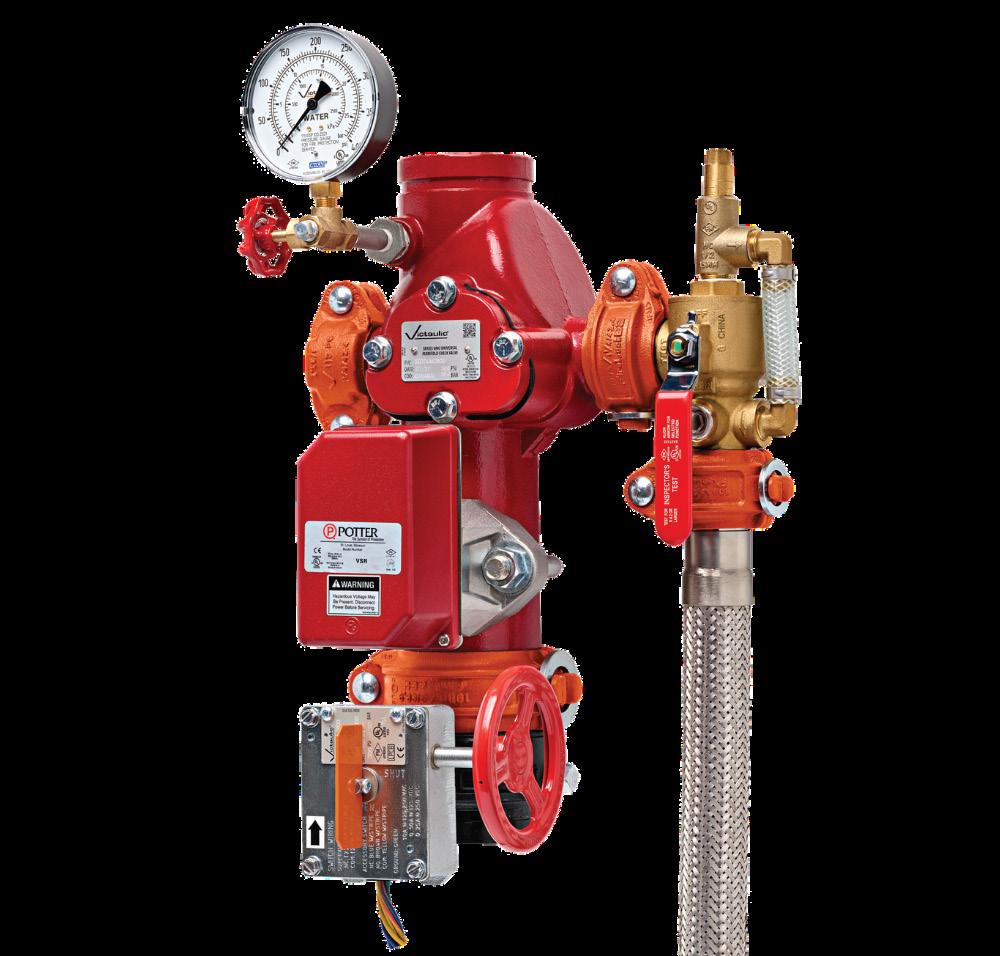


COMPREHENSIVE SPRINKLER CATALOG
• Pendent | K3.0, K4.9, K5.6, K6.9
• Concealed Pendent | K4.9, K5.6
• Horizontal Sidewall | K4.2, K4.4, K5.6
• 1” cover plate adjustment available

D’ARCY



At this year’s National Fire Protection Association’s (NFPA) Conference & Expo, Bob Caputo, CFPS, president of the American Fire Sprinkler Association (AFSA), attended a seminar on building awareness about the fire protection industry and sprinklers. He was surprised to hear it recommended that education begin in elementary school—as young as second grade. “The speaker said talking to high school students or even those in middle school was too late,” Caputo remembers. “It was shocking that we needed to lay the groundwork so early, and it got me thinking about what we as an association could do and what our members could do.”
Little did Caputo know, one AFSA Contractor member was already doing just that! Jimco Fire Protection, Inc. in Au Gres, Mich., has hosted second-graders from his local elementary school for many years.
“We bring kids in and give them on a tour of the facility—our offices and fabrication shop,” says Greg Dittenber, co-owner and vice president of Jimco. “It’s developed over the years into an interactive event. Our designer shows them how we draw things out on a computer. We show them a sprinkler plan for our building, and the kids find the sprinkler heads on the drawing and then on our ceiling. We finish with a video of a side-by-side burn demonstration and a snack. Each child also takes a goodie bag to home with trinkets from our vendors and information about fire safety and fire sprinklers.”
Dittenber says he’s always surprised by how interested and engaged the children are. “They ask good questions; it seems to resonate with them. When they leave here, they know what a sprinkler is and does, and we’ve dispelled the myths they’ve seen and heard.”
The field trip is part of the local elementary school’s annual outing, during which students visit local businesses and learn more about their community. Dittenber and his wife Carla collect items for their goodies bags when attending events such as AFSA43.
They encourage other AFSA members and chapters to consider putting on this type of event. “We didn’t know what to do the first year we were asked to participate. We threw something together, and it worked. Now, everyone here looks forward to it! It’s a pretty easy thing to put on, and it’s teaching these kids about fire safety and this industry.” n

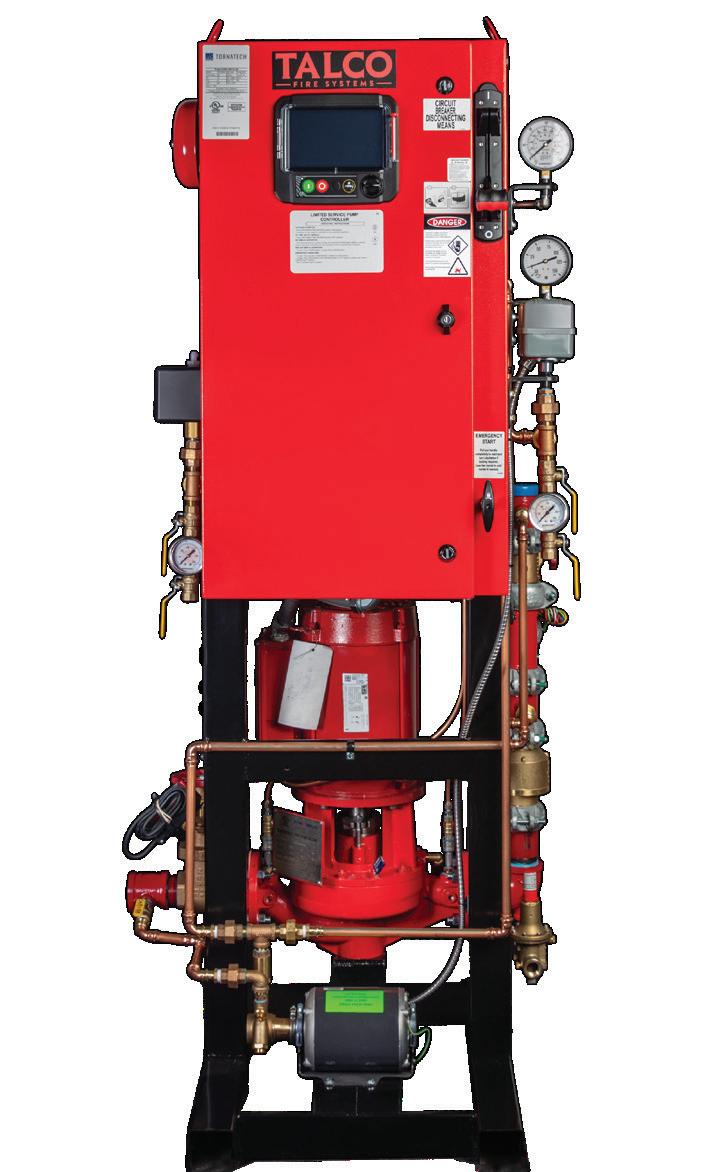

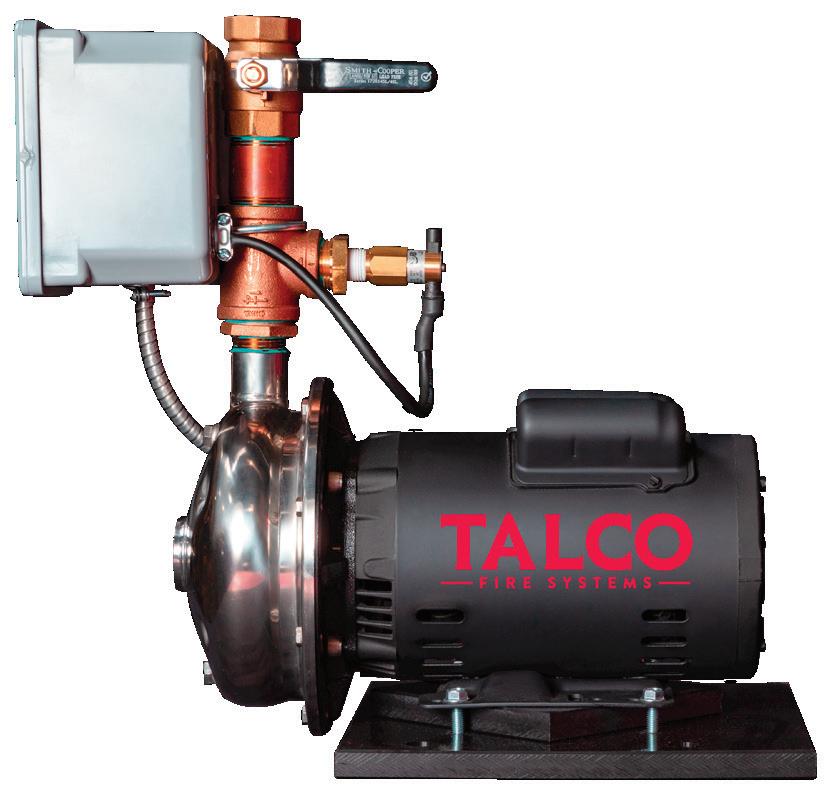


DeMatha Catholic High School has won the 10th annual Design Challenge competition hosted by the University of Maryland’s Department of Fire Protection Engineering (FPE), earning its second victory since 2016. The “Amigos” team demonstrated the ability to build a system that successfully detects and suppresses a flame in a reduced-scale house model. Their innovative design impressed judges and team mentors assessing creative and innovative approaches.
Six other schools participated in the challenge this year, including Atholton High School, Elizabeth Seton High School, Mount De Sales Academy, Notre Dame Preparatory School, Old Mill High School, and Woodlawn High School. “The Design Challenge is our premium outreach event for high-school students and is a fantastic introduction to the principles of engineering design and fire protection engineering,” says Arnaud Trouvé, chair of the department. “The event also serves as a recruitment tool for FPE.”
Each year, the challenge brings together high school teams from local areas to expose students to basic principles of fire safety engineering, construction skills, and the scientific method. The goal is that participation in the program will boost student confidence in pursuing STEM careers, and the department welcomes excitement to learn about fire protection engineering, a field not broadly known.
Teams typically formed by three to five students are assembled and paired with a professional or teacher mentor in October to
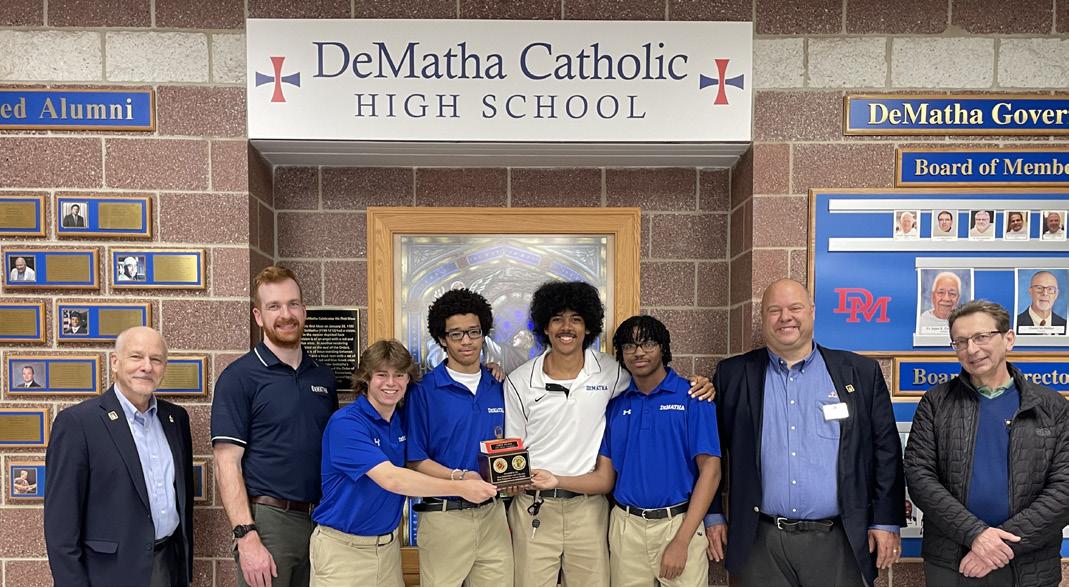
begin learning challenge guidelines and review supporting materials provided by the department. Early design and testing of housing models begins in February through competition day in April.
The race for first place is held in the U.S. Department of Justice’s Bureau of Alcohol, Tobacco, Firearms and Explosives (ATF) facilities in Beltsville, Md., where each team is given a chance to showcase their prototypes in a burn test to demonstrate efficient fire suppression methodologies. The world-class ATF facilities ensure that a safe environment is kept in place for the participants.
The Design Challenge is proud to thank AFSA for their annual donation that supports the supplies provided to the schools, prizes provided to winning teams, and marketing for the program. “It was a pleasure to attend this year’s competition, and I thoroughly enjoyed getting to know the competitors and their systems,” states AFSA’s Vice President of Engineering & Technical Services John August Denhardt, P.E., FSFPE, and alumnus of UMD’s FPE program, who attended the event with Past AFSA Chair of the Board Jack Medovich, P.E., Summit Companies and a fellow alumnus. “AFSA is committed to supporting this endeavor to educate more students about the exciting field of fire protection engineering.”
Visit https://fpe.umd.edu/FPEDC to learn more. n
ABOUT THE AUTHOR: Daniela Benites is the communications coordinator for the University of Maryland’s Chemical and Biomolecular Engineering, Materials Science and Engineering, and Fire Protection Engineering

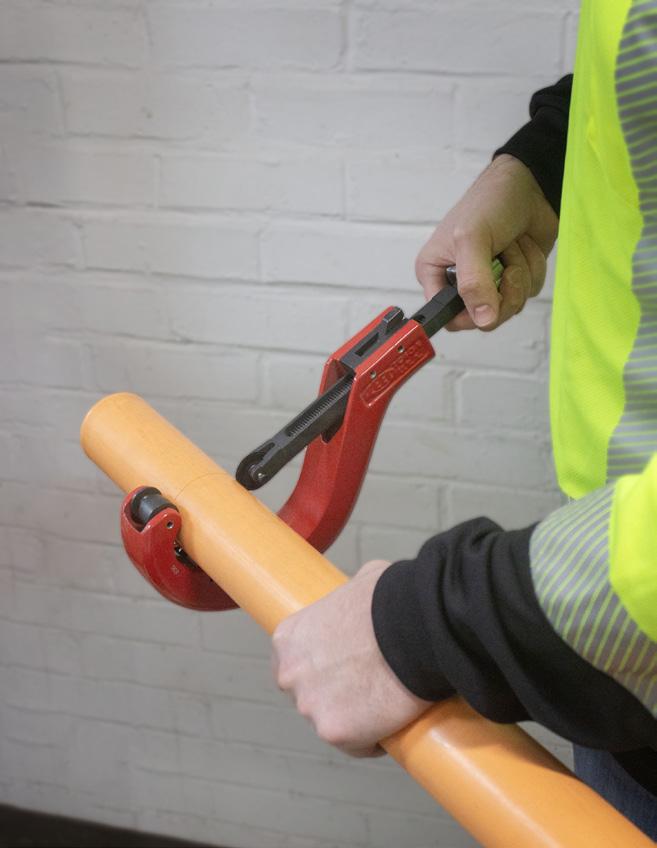
Produces a square cut on PVC/CPVC so the pipe bottoms out in the fitting for best fit.

Deburr and chamfer to manufacturers’ standards in seconds.
DEB4 creates a smooth pipe end so solvent spreads evenly as pipe is joined. Fits six sizes of 1 1/4” - 4” PVC, CPVC, PP and ABS pipe.
For deburring 1/2”, 3/4”, and 1” PVC, CPVC, PE, ABS and PP pipe in IPS or CTS, choose DEB1IPS or DEB1CTS, both with knurled grips for slip resistance.
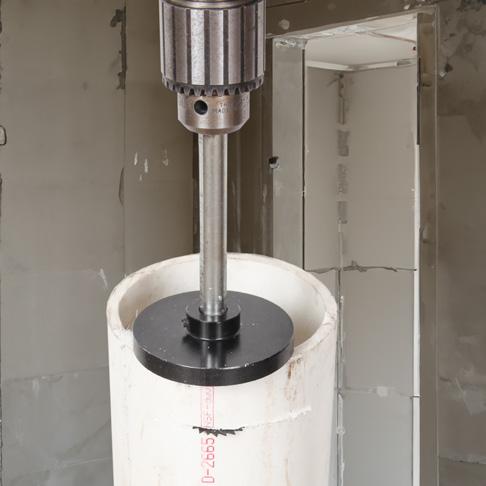
Conveniently cut from the inside using a saw-toothed blade. Exclusive, adjustable guide doubles as a depth gauge.



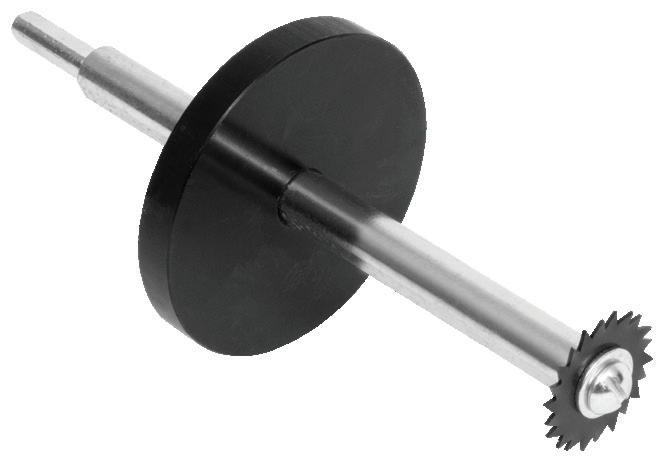

Two forces have come together to increase awareness about the fire protection industry. ARGCO and the Arkansas Fire Sprinkler Contractors Association, a chapter of the American Fire Sprinkler Association (AFSA), have created a demonstration trailer showcasing the industry and its opportunities.
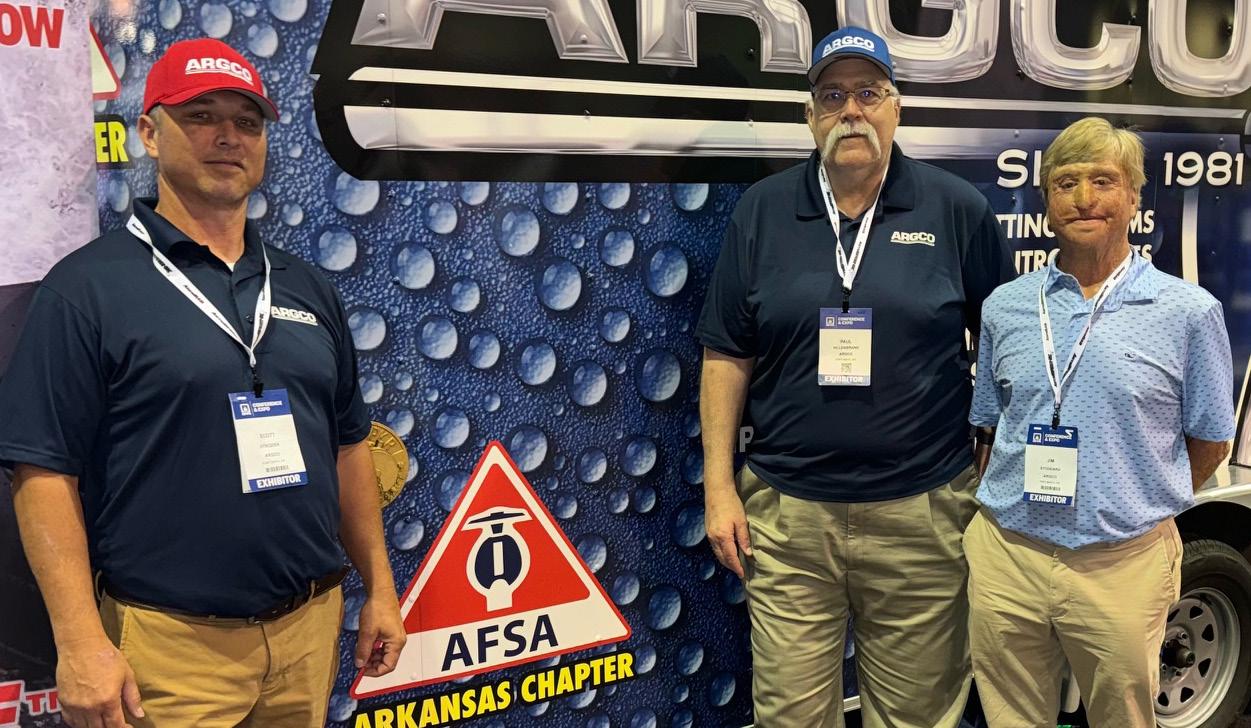
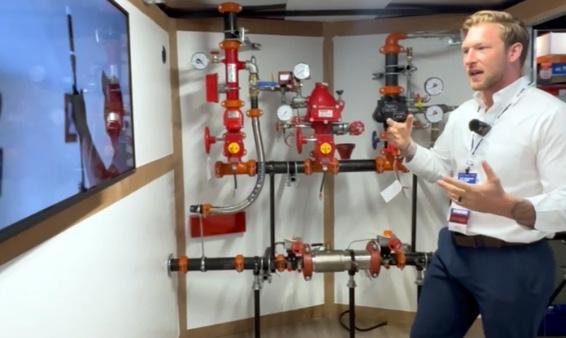

“We’re using this trailer to help recruit the next generation of fire sprinkler professionals,” comments Chapter Executive Director Coleman Farrar, CEO at Fire Sprinkler Advisory Services, LLC, in Van Buren, Ark. “We attended the NWA Build My Future event in Springdale this year, which brought in over 1,600 high school students,” says Farrar. “We also attended ABC’s Build My Future event in Conway with similar results.”
The idea for the trailer came up during a 2023 chapter meeting. Jackie Dolan with ARGCO was talking to Owner Jim Stoddard, and he quickly directed Dolan to purchase a trailer and truck to haul it. The trailer was outfitted at Contractor Member Northwest Fire Protection in Fort Smith with several different wet pipe risers and four mounted TVs displaying career information.
“We appreciate all the support ARGCO provides for our chapter. Whatever we’ve dreamed up, they’ve been super supportive,” states Farrar. “They really stepped up to the plate.”
The trailer has hit the road running. In April, it was on display at the AFSA Mid-Year Leadership Conference, where chapter officers from around the country gathered to exchange ideas and information at AFSA’s headquarters in Richardson, Texas. In June, it traveled to the NFPA Conference & Expo in Orlando and was on display in ARGCO’s booth in the exhibit hall. This fall, ARGCO will showcase it at AFSA43 in Denver.
Russell Bryant with ARGCO comments, “This was a perfect opportunity to get involved. Our customers have always directed us on the future on our company—when they need something, we get it. We love partnering up with our fellow contractors. People joining together with local chapters is the best way we can gain power.”
For more information about the trailer and the chapter, email Farrar at afscaexecdir@gmail.com or Bryant at russb@argco.com. n









When the Runyan Acres (Ark.) Volunteer Fire Department learned they were a recipient of a $750 stipend to support community outreach during 2024 Home Fire Sprinkler Week this past May, they scheduled an open house event. The funds were used to purchase an Oculus Virtual Reality (VR) headset to show the Home Fire Sprinkler Coalition (HFSC) VR fire and sprinkler educational video. They also purchased a canopy tent with the fire department and HFSC logos to attract open house visitors. The combination worked well. More than 250 members of their community attended, including a state representative. According to Fire Chief Dalton Shannon, the department would not have participated in Home Fire Sprinkler Week without the stipend. He said the open house and VR experience of an actual house fire “really opened the door for conversation,” explaining that many people didn’t know home fire sprinklers existed.
Thanks to a grant from State Farm, HFSC awarded $750 stipends to 40 fire departments that submitted plans to support their grassroots safety education activities during Home Fire Sprinkler Week. The stipends were used to produce educational banners, purchase monitors to show educational videos, boost social media messages and conduct live fire and sprinkler demonstrations. Like Runyan Acres, some fire departments purchased virtual reality headsets. Fire departments that decided to build home fire sprinkler displays received the stipend as well as a free RiserPACK bundled by AGF Manufacturing with components donated by Potter, Viking, and Watts.
New this year, HFSC’s stipends could also be used to print and disseminate flyers or posters that were generated with the new Home Fire Sprinkler Studio. Also funded through a State Farm grant, this free, online studio can be easily used by fire departments to tailor and customize educational content with their logos, website URLs and other local information.
In addition to purchasing a monitor, the Newton County (Ga.) Fire Department used the studio to create the fire timeline poster and displayed it during their open house. According to Fire Safety Specialist James Franklin, community leaders who attended the event saw the timeline and watched the VR video. They were surprised at how fast home fires become deadly and how quickly and effectively installed fire sprinklers work, Franklin says. He also

noted the new resources would help get the conversation started to support home fire sprinklers in new construction. The department continues to use the items purchased with their stipend in monthly outreach to educate the community and leaders.
As with previous years, 2024 Home Fire Sprinkler Week continued to build momentum. Its digital media campaign reached more than 2.3 million people throughout North America. The campaign focused on the home fire problem and the need for better under¬standing of the life safety benefits of installed home fire sprinklers. Much of this success came as members of the fire service, other fire safety advocates and the fire sprinkler industry utilized HFSC’s dedicated Sprinkler Week webpage to share social media and website content. To boost interest, there was a different theme with suggested videos, graphics and sample text each day of the week. Another sign of momentum is that more than 13,700 internet users visited HFSC’s YouTube channel, spending 350 hours viewing content during the week.
Between the digital campaign and community outreach programs, Home Fire Sprinkler Week has become an increasingly successful hybrid campaign, uniting the very best of fire service in-person and online educational outreach to help achieve local community risk reduction goals.
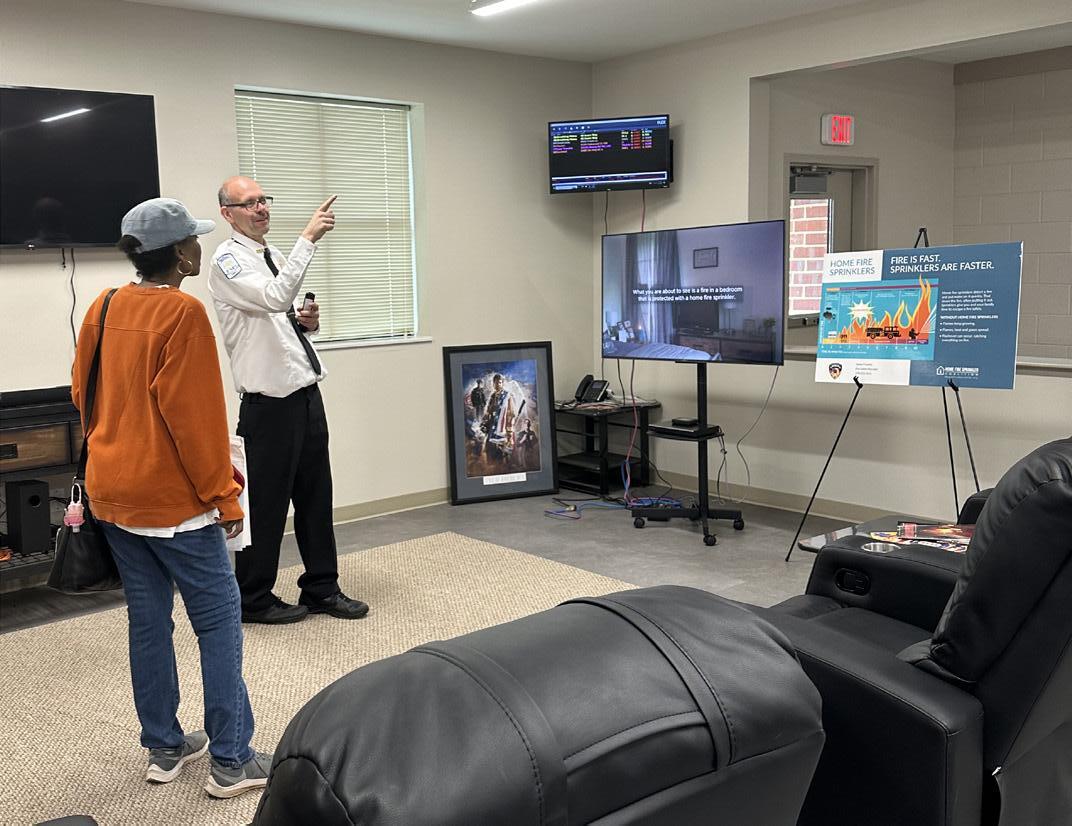
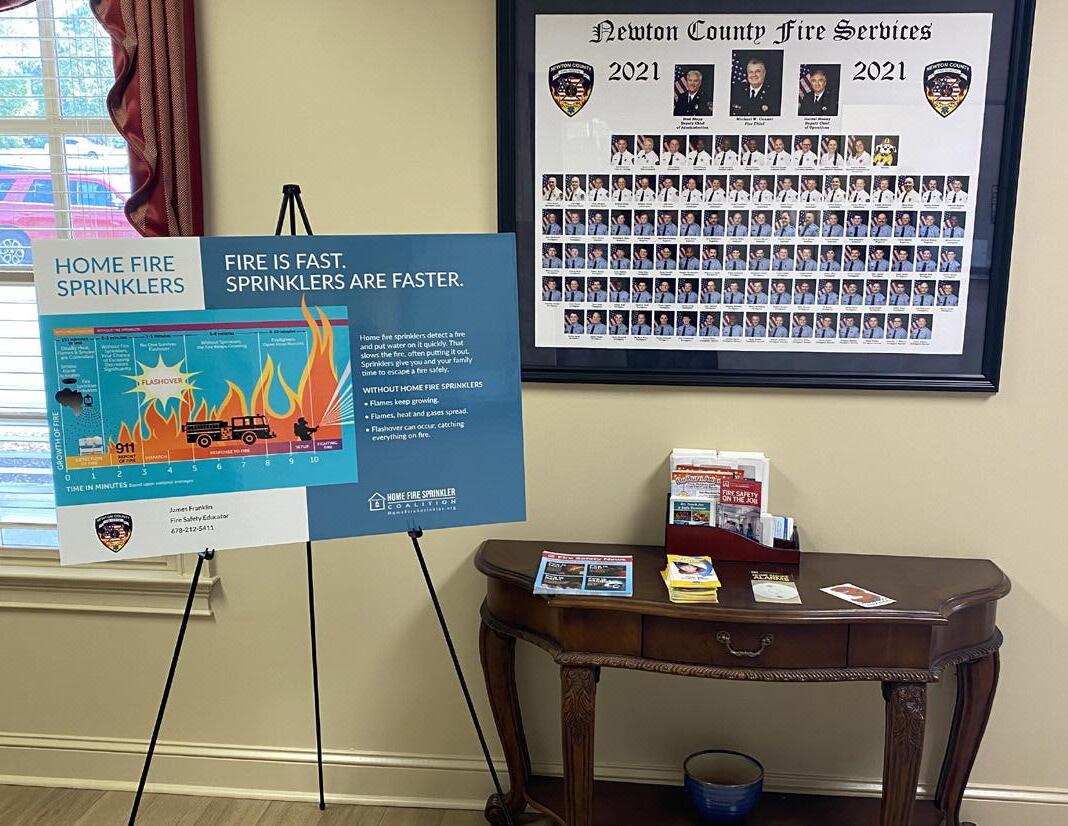
What to watch for next: HFSC will spend the rest of the year promoting its free Built for Life Fire Department program with a new video and website featuring powerful testimonials from fire departments that are making home fire sprinkler education a local priority. Finally, HFSC will continue to promote the studio, including resources to customize content for 2024 Fire Prevention Week. For more information visit HomeFireSprinkler.org. n
AUTHOR: Peg Paul is the founder/president of Peg Paul & Associates (PPA), a marketing communications firm that specializes in fire and life safety education and awareness programs. Paul has been the communications manager for HFSC since 1997, where she oversees the development and implementation of educational programs for members of the fire service, local officials, consumers, home building industry, real estate and insurance agents, water purveyors, and other targeted groups. Paul and her team have secured more than $10 million in Federal and corporate foundation grants. Paul serves on the board of the NFPA Research Foundation and the IAFC Life Safety Section. She served on the Phoenix Society for Burn Survivors board for 10 years. In 2023, Paul received the CFSI/IFSTA Dr. Anne W. Phillips Award for Leadership in Fire Safety Education. She was named AFSA’s 2014 Fire Sprinkler Advocate of the Year.


The American Fire Sprinkler Association (AFSA) is proud to announce that its Beginning and Intermediate Design Schools have been updated to NICET’s new exams for Water-Based Systems Layout (WBSL) certifications.
NICET’s Water-Based Systems Layout certification program is for engineering technicians engaged in the layout and detailing of water-based systems that must meet code and statutory requirements. Its exams have been updated as of July 8, 2024. Graduating from AFSA’s schools may help students be better prepared for the NICET WBSL exam.
“This school offers trainees a focused learning path that teaches them to understand the layout and basics of NFPA 13 so that design criteria, including water supplies and sprinkler location, can be more easily located and applied,” says AFSA Vice President of Education Services Leslie Clounts. “No one expects you to memorize NFPA 13, but knowing where to find the information quickly can make you a more proficient designer, and definitely helps when taking timed certification exams like NICET’s WBSL.”
Take advantage of this opportunity by attending the last schools being held in 2024: The next Beginning Design School will be Oct. 29 – Nov. 22 and the next Intermediate Design School will be Nov. 5-15. Both schools will be offered as a hybrid format of virtual and in-person learning.
New and improved class instruction now includes time in AFSA’s new training lab! Said one recent graduate, “The class was very engaging, I enjoyed being able to do hands-on activities in the lab; it helped me connect the knowledge from paper to real life application.”
The Beginning Design School presents a comprehensive, practical approach to preparing fire sprinkler system drawings. Over a three-week period, students will attend six live webinars studying and reviewing the installation and design approach requirements of NFPA 13 (2022) while completing self-paced exercises and module assessments. Q&A sessions and open discussions will also be included as part of the online instruction. The second part of the class will be a week of in-person training, preparing fire sprinkler system layout, shop drawings, and hydraulic calculations by hand. The course concludes with a comprehensive exam of the class content including the installation requirements and hydraulics. There is no CAD or third-party software taught in this class.
Student feedback on the school has been excellent. “I thought Josh was a great instructor. He was extremely engaging, understanding, and knowledgeable. I also thought Eric was very knowledgeable on each subject. While he only taught us for two days, I feel I learned a lot from him. Transportation was perfect, lunches were delicious, and the class was engaging.”
The school will prepare the student to:
• Accelerate the comprehension of plans and various types of building construction for proper sprinkler spacing applications.
• Determine the proper sprinkler system layout and installation requirements and methods.
• Interpret sprinkler specifications, plans (shop drawings), manufacturer’s technical data sheets, and flow tests.
• Identify sprinkler types, system types, pipe types, hangers, fittings, system components, etc.
• Explain the coordination with other trades—plumbing, mechanical, electrical, and structural.
• Prepare hand sprinkler drawings and hydraulic calculations and identify the hydraulic inputs to explain computer outputs.
Another student commented, “[Josh McDonald] made the learning experience a lot more enjoyable and made the process easy to learn for everyone’s learning style and pace. Everything was above expectations.”
This class is designed for trainees and entry-level technicians with at least six months experience as well as those with experience in the sprinkler trade looking to make the transition to system layout. Visit www.firesprinkler.org/ programs/beginning-fire-sprinklersystem-planning-school/to learn more and to register.
“I spent four-and-a-half years in college. This course, by an incredibly large margin, was the best course I have ever taken,” submitted one graduate from the school. “In addition, Josh was the best instructor I have ever had. He made insurmountable concepts easier to understand to someone who only has four months in the industry. I eagerly await the time I can take the next class with Josh and this organization. ... The pace and overall ability of the instructors is without comparison in my experience.”
Experienced layout technicians will find AFSA’s Intermediate Design School a blended learning course useful to understand the tools they utilize in-depth and gain a deeper knowledge of layouts for standpipe systems, fire pumps, seismic protection, and the design requirements for general storage.
In addition to mastering requirements in NFPA 13, NFPA 14, and NFPA 20, students will utilize computer modeling software to apply design requirements learned throughout the course, becoming familiar with the BIM process. This course begins with an orientation and two three-hour webinars followed by five days of guided, in-person instruction. The school will prepare the student to:
• Classify commodities and storage arrangements.
• Compare installation requirements for storage sprinklers (CMDA, CMSA, and ESFR).
• Use computer modeling of a sprinkler system to illustrate and confirm installation requirements for storage sprinklers (CMDA, CMSA, and ESFR).
• Determine a standpipe system’s appropriate component, installation, and design requirements.
• Recognize the components and prepare shop drawings where seismic protection is required.
• Select an appropriate fire pump based on available supply and system demand and verify using a computer model.
Instructor evaluations show that student retainment and engagement is paramount. “Josh McDonald was very engaging and funny which made it easy to stay interested in the material. He did a good job explaining the why behind everything,” says one graduate.
“Kevin was a great instructor, very polite and above all very knowledgeable. Josh is a very good teacher, explaining things in a manner that made some of the technical parts of our jobs a lot more understandable. His analogies were a great way to paint a better picture as well,” comments another student.
This class is designed for competent trainees and technicians with at least one year of system layout experience. No prior Hydratec or Autodesk® Revit® experience is required. Students should be computer literate.
Learn more and register at www. firesprinkler.org/programs/intermediatefire-sprinkler-system-planning-school/.


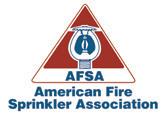



As the new school year approaches, college students nationwide are preparing to move into campus dormitories and off-campus housing.
The National Fire Protection Association® (NFPA®) and The Center for Campus Fire Safety™ (CCFS) collaborate on the annual Campus Fire Safety Month campaign every September to ensure students, parents, and campus housing staff and administrators have the relevant information and resources they need to make resident living spaces as safe as possible from fires and associated hazards.
The latest statistics, according to NFPA, show that U.S. fire departments responded to an estimated average of 3,331 structure fires each year in dormitories, fraternity houses, sorority houses, and barracks between 2018 and 2022. Fires in dormitory-type properties caused an annual average of 21 civilian deaths, 23 civilian injuries, and $21 million in direct property damage during that period. Approximately three out of four fires in these properties began in the kitchen or cooking area, accounting for 58 percent of the civilian injuries
Fire Prevention Week October 6-12, 2024
The National Fire Protection Association® (NFPA®) announced “Smoke alarms: make them work for you!™” as the official theme for Fire Prevention Week™ (FPW), October 6–12, 2024. This year’s focus on working smoke alarms comes in response to NFPA data, which shows that the majority of U.S. home fire deaths continue to occur in homes with no smoke alarms or no working smoke alarms.
Plan your FPW activities with NFPA’s digital toolkit. They have provided everything you need for a successful campaign from its latest research report on smoke alarms to customizable materials to help promote your campaign. Toolkit material also available in Spanish and French.


Fire Prevention Week Theme Art: Increase awareness, and use the Fire Prevention Week logos on your print pieces, website, or social media channels.
Community Involvement Resources: Community event flyer, FPW Out of the Box ideas, FPW selfie frame.


Customized Templates: Sample press release and gubernatorial proclamation proided to easily promote FPW.
Social Media Cards: Use cards on your social media channels to highlight the importance of smoke alarms, and link back to fpw.org. All social media cards are available in English, Spanish, and French.


Lesson Plans: Smoke alarm mini lesson plans for adults, preschoolers and kindergarteners, and grades 1-2.
NFPA Guides and Reports: Smoke Alarms in U.S. Home Fires, Fire Safety Messaging Desk Reference, and Smoke Alarm Installation Guide.
To view and download all materials, visitnfpa.org/events/fire-prevention-week/fireprevention-week-toolkit. Holding an FPW event? Email Sprinkler Age your story and photos at info@sprinklerage.com.
and 11 percent of the direct property damage. Cooking equipment was involved in nearly eight out of 10 fires.
“As students return to campus this fall, many of them will be preparing their own meals. Some will be using kitchen appliances for the first time or cooking food after studying or coming home late from a party,” said Lorraine Carli, vice president of Outreach and Advocacy at NFPA and CCFS Advisory Council member. “The data tells us that more education is needed about when and where cooking hazards exist, along with ways to prevent them. Campus Fire Safety Month is a great way to raise public awareness of fire safety on our college campuses.”
NFPA and CCFS offer a wealth of tips and resources for cooking safely in resident housing, including these key messages:
• If you are sleepy or have consumed alcohol, don’t use the stove or stovetop.
• Stay in the kitchen while preparing meals; use a timer to remind you that you’re cooking.
• Keep anything that can catch fire—oven mitts, wooden utensils, food packaging, towels or curtains—away from your stovetop.
Further, while cooking remains a leading cause of fires in campus housing, there is growing concern on college campuses about the increasing number of fires caused by lithium-ion batteries. Alan Sactor, vice president of the Center for Campus Fire Safety, said, “Micromobility devices like e-bikes and e-scooters and smaller electronics such as cell phones, laptops, and tablets are vital to the daily life of college students. However, the mishandling or misuse of these batteries can lead to safety hazards such as overheating, fire, or even explosions. NFPA and the CCFS are working together to help educate students on how to use, store, and charge these devices safely to reduce the risk of fire.”
NFPA and CCFS provide several resources and tips for safely buying, charging, storing, and using lithium-ion batteries:
• Use only charging equipment that is supplied with your device.
• Do not keep charging the device or device battery after it is fully charged.
• Stop using your device if the battery shows signs of damage, such as an unusual odor, excessive heat, popping sounds, swelling, or change in color.
In 2023, CCFS launched the Micromobility/Lithium-Ion Battery Fire Reporting Program. The program aims to support the development of educational programs, policies, and advocacy efforts to help reduce the risk of these battery fires on college campuses. Learn more and submit a fire incident on the CCFS website. For more information about this and other resources, visit nfpa.org/campussafety or myccfs.org/. n

AFSA’s Technical Advisory Council (TAC) met on July 25, 2024, to continue their efforts to establish AFSA’s positions on upcoming issues for the second draft meetings for the 2026 editions of NFPA 25, Standard for the Inspection, Testing, and Maintenance of Water-Based Fire Protection Systems , and NFPA 200, Standard for Hanging and Bracing of Fire Suppression Systems
In addition to reviewing proposed changes to the codes and standards, the TAC reviewed a decision that came down from the NFPA Standards Council regarding multirepresentation on NFPA technical committees. Historically, AFSA has held two seats on each of the following committees: AUT-SSI (NFPA 13 – Installation), AUT-SSD (NFPA 13 – Discharge), AUT-HBS (NFPA 13 – Hanging and Bracing), AUT-RSS (NFPA 13R/13D – Residential), but AFSA will now only have one seat on those committees.
As stated in the letter from the Standards Council Secretary:
The Standards Council has been reviewing multi-representation across all technical committees. This endeavor has taken the course of multiple meetings with the Council considering each committee and each organization individually and methodically... At the April 17-18th Standards Council Meeting, the Council voted to remove AFSA’s multi-representation.
While AFSA was disappointed by the decision, we are not discouraged. AFSA staff will still hold the organizational seat on these core technical committees to represent the collective position of the TAC and AFSA membership. There continue to be additional opportunities to serve on NFPA technical committees as an organizational representative for AFSA, and those actively involved in the TAC (not necessarily voting members) will have priority. To date, AFSA members have been approved by the TAC to serve as organizational representatives on the Technical Committees on Foam (NFPA 11), Aerosol Products (NFPA 30B), Finishing Processes (NFPA 33), Internal Combustion Engines (NFPA 37), Laboratories Using Chemicals (NFPA 45), Detention and Correctional Occupancies (NFPA 101/5000), Fire Protection Features (NFPA 101/5000), Health Care Occupancies (NFPA 101/5000), and Hybrid Fire Extinguishing Systems (NFPA 770). It should be noted that these are only approved through TAC to represent AFSA and all applicants still need to be appointed by NFPA Standards Council.
The latest appointments by NFPA Standards Council for AFSA Organizational Representatives on NFPA Technical Committees include:
• Kevin Hall, AFSA, NFPA 14 (SPI-AAA), Principal
• Brent Kearney, Protection Design and Consulting, NFPA 420 (CGP-AAA), Alternate
• Steve Leyton, Protection Design and Consulting, NFPA 420 (CGP-AAA), Principal
It cannot be stressed enough that the TAC is intended to represent AFSA’s position on technical matters. While voting seats on the TAC are currently limited to 15 contractor members, all AFSA members are permitted—and encouraged!—to attend the meeting, participate, and voice your opinions so that vote on issues considering a wider perspective. The next TAC meeting will be held in early November. If any AFSA member is interested in participating, please reach out to me at khall@firesprinkler.org to be added to the communications list. n

KEVIN HALL, M.ENG, P.E., ET, CWBSP, PMSFPE AFSA DIRECTOR OF ENGINEERING

E. Parks Moore, P.E., Chair (National Scope)
S&S Sprinkler Co. (Pye-Barker)
Alternate: Phillip Clemen
Chris Campion (Region 6)
Eastern Fire and Safety
Alternate: Thomas Carlock
Christopher Caputo (Region 2)
Metro Fire Equipment
Alternate: Bret Evans
Jason Gill (Region 6)
Crews and Gregory Fire Sprinkler, Inc.
Alternate: Bob Beckwith
Matthew Heidler (National Scope)
Johnson Controls Fire Protection
Alternate: Kevin Galligan
Chris Johnson (Region 5)
Piper Fire Protection
Alternate: Steven Helkin
Chris Kachura (National Scope)
VSC Fire and Security
Alternate: Andrew Hafner
Adam Levine (Region 6)
Capitol Fire Sprinkler
Alternate: Chris Ribando
Jeff Lewis (Region 6)
VSC Fire and Security
Alternate: David Victor
Dale Lindh (National Scope)
Summit Companies
Alternate: Paul Szafranski
Eric Rieve (Region 7)
Rieve Fire Protection
Alternate: Connor Rieve
Steven Scandaliato (Region 4)
SDG, LLC
John Schotz (National Scope)
Davis Ulmer Sprinkler Co. (APi Group)
Alternate: Steve Ulmer
Taylor Schumacher (Region 3)
Security Fire Sprinkler
Alternate: Calen Schumacher
Byron Weisz (Region 1)
Cen-Cal Fire Systems, Inc.
Alternate: Erik Weisz
KEVIN HALL, M.Eng, P.E., ET, CWBSP, PMSFPE Staff Liaison
American Fire Sprinkler Association
AFSA Manufacturers/Supplier Council Chair
Phil Schechinger, ASC Engineered Solutions
Alternate: AFSA Manufacturers/Supplier Council Vice Chair Andy Kaempfer, Safe Signal
UL Solutions
Kerry Bell, Alternate: Jeff Hebenstreit
Victaulic
Kevin Kelly, Alternate: Alaina Schwall
Johnson Controls
Melisa Rodriguez
Reliable Automatic Sprinkler Co.
Cary Webber, Alternate: Brandon Telford
Victaulic
Kevin Kelly, Alternate: Alaina Schwall
Viking Corporation
Martin Workman, Alternate: Katie Teunessen
TAC meetings are open to all AFSA members in good standing. Contact your regional representative to discuss any issues that the TAC should hear. While the number of voting members on the TAC is currently restricted to 15 contractor companies, there are other opportunities for interested AFSA members. If you are interested in serving on an NFPA or UL technical committee, email technical@ firesprinkler.org. All technical committee appointments are made by the TAC.
AFSA’s Engineering & Technical Services Department staff present technical challenges each issue. These exercises are also excellent preparation for professional certification tests and may count as CEUs. Check with your certification organization. Answers to this issue’s questions will be presented in the next issue.
1. Water mist systems are inspected in accordance with what NFPA standard? NFPA 25-2023: 1.1.2.1 The types of systems addressed by this standard include, but are not limited to, sprinkler, standpipe and hose, fixed water spray, private fire hydrants, water mist, and foam water.
A. NFPA 25
B. NFPA 750
C. NFPA 13
D. Water mist systems are not covered by any NFPA standards.
2. Foam water sprinkler systems are designed and installed are covered by what NFPA standard? NFPA 11-2024: 6.1.2 The purpose of these requirements shall be to provide a reasonable degree of protection for life and property from fire through installation requirements for foam-water sprinkler and spray systems based on sound engineering principles, test data, and field experience.
A. NFPA 11
C. NFPA 19
B. NFPA 16
D. NFPA 27
3. Fire protection of cannabis growing and processing facilities is/ will be covered by what NFPA standard? Proposed standard NFPA 420-2027: 1.3.1 This standard shall apply to all facilities where cannabis is being grown and processed.
A. NFPA 12
C. NFPA 420
B. NFPA 18
D. NFPA 1011
4. The protection of cultural resource properties such as museums, libraries, and places of worship is covered by what NFPA standard? NFPA 909-2021: 1.1.1 This code describes principles and practices of protection for cultural resources properties (including to, but not limited to, museums, libraries, and places of worship), their contents, and collections, against conditions or physical situations with the positional to cause damage or loss.
A. NFPA 13
C. NFPA 909
B. NFPA 18
D. NFPA 1016
5. Which standard is intended to prescribe minimum safeguards for construction, alterations, and demolition operations in order to provide reasonable safety to life and property from fire during such operations? NFPA 241-2022: 1.2 This standard is intended to prescribe minimum safeguards for
construction, alterations, and demolition operations in order to provide reasonable safety to life and property from fire during such operations
A. NFPA 3
C. NFPA 241
B. NFPA 4
D. NFPA 291
For this issue, we are going to challenge your knowledge of NFPA 13, 13D, and 13R standards.
1. True or False? NFPA 13D requires a local alarm anytime a sprinkler operates if working smoke alarms are not installed in accordance with NFPA 72.
A. True
B. False
2. A sprinkler system in a four-story apartment building is typically installed per the requirements of which standard?
A. NFPA 11
C. NFPA 13R
B. NFPA 13D
D. NFPA 15
3. For a sprinkler system designed in accordance with NFPA 13R2025 edition, which statement is true regarding water supplies?
A. Any water supply that meets NFPA 13-2025 edition is acceptable. This means if a fire pump system is needed, the fire pump systems must fully comply with NFPA 20-2023 edition. Outside hose allowance or domestic demand must be added as required.
B. Any water supply that meets NFPA 13-2025 edition is acceptable. However, if a fire pump system is needed, the fire pump systems must be listed only as a NFPA 13R fire pump system.
C. Water supplies must have a minimum duration of 90 minutes.
D. The minimum static pressure is 50 psi and the minimum water flow rate is 250 gpm at 25 psi residual.
4. For a sprinkler system designed and installed in accordance with NFPA 13D-2025 edition, which statement is correct:
A. All components essential to sprinkler performance must be listed.
B. Pumps, gauges, valves, tanks, and hangers do not have to be listed.
C. All components essential to sprinkler performance must be listed except backflow prevention devices approved by the water authority.
D. All components essential to sprinkler performance must be listed except water supply pipe and fittings, water meters, and tanks.
AFSA’s Vice President, Membership & Chapter Development, Meda Merritt, CAE, has received the Dallas Fort Worth Association Executives (DFWAE) Wayne James Award for her efforts and contributions to DFWAE and the association community.
The Wayne James Award is presented to the member who recruits the most new members to the society. Named in honor of Wayne James, who served as DFWAE president from 1991 to 1992, this award recognizes outstanding member recruitment efforts. Merritt has recruited new DFWAE members and significantly contributed her expertise and thought leadership to the DFWAE Membership Committee.
OCTOBER 2024
2-4
• Advanced Hydraulics Workshop
AFSA Headquarters, Richardson, TX firesprinkler.org/programs/advanced-sprinkler-hydrauliccalculations-workshop/ 14-16
• Sprinkler Hydraulics Calculations Workshop
AFSA Headquarters, Richardson, TX firesprinkler.org/programs/calculations/ 29 – Nov. 22
• Beginning Design School
AFSA Headquarters, Richardson, TX firesprinkler.org/programs/beginning-fire-sprinkler-systemplanning-school/
NOVEMBER 2024 5-15
• Intermediate Design School
AFSA Headquarters, Richardson, TX firesprinkler.org/programs/intermediate-fire-sprinklersystem-planning-school/ 6-7
• Beginning ITM Workshop
AFSA Headquarters, Richardson, TX firesprinkler.org/programs/beginning-itm-workshop/ 13-15
• Intermediate ITM Workshop
AFSA Headquarters, Richardson, TX firesprinkler.org/programs/intermediate-itm-workshop/ 19-20
• Fire Pump ITM Workshop
AFSA Headquarters, Richardson, TX firesprinkler.org/programs/fire-pump-itm-workshop/
“Meda deserves every award and accolade she receives. She is an amazing woman who is always upbeat, positive, and inspirational,” says AFSA President, Bob Caputo, CFPS. “She lights up the room with enthusiasm noticeable to everyone around her. This award exemplifies the fact that people are naturally drawn to Meda. She recently earned her CAE designation (Certified Association Executive), which is no small accomplishment, adding value to herself and our association.”

The American Fire Sprinkler Association (AFSA) is proud to announce its sponsorship of a recent NFPA report titled “Classification of Modern Vehicle Hazards in Parking Structures and Systems — Phase II.” The study was conducted is now published online at nfpa.org/education-andresearch/research/fire-protection-research-foundation/projects-andreports/modern-vehicle-hazards-in-parking-garages-vehicle-carriers.
AFSA’s High School Senior Scholarship Contest educates students about automatic fire sprinklers and the fire sprinkler industry and awards scholarships! From now until January 1, 2025, eligible high school students (class of 2024-2025) can visit afsascholarship.org/ to apply for one of five $1,000 scholarships. Applicants visit the website, read a short passage on fire sprinklers and the industry, and answer questions about the reading. Each correct answer offers one entry into the scholarship contest, with a total of eight entries possible per applicant. Winners are randomly selected to receive a one-time $1,000 AFSA scholarship payable to their respective college, university, or trade school. Visit afsascholarship.org.
AFSA’s online learning platform offers 24/7 access to CEUs and/or CPDs from its educational events, including live webinars. AFSA On-Demand offers fire sprinkler contractors and other professionals access to the best in specialty education anytime. These courses are presented by experts in the fire protection industry and are carefully developed to offer convenience and flexibility. Visit www.firesprinkler.org/ondemand for details.
Sign up to receive your own free copy of Sprinkler Age magazine— print, digital, or both! Qualified industry professionals can sign up for a free subscription online at sprinklerage.com/subscribe. For more information or to view the digital edition, visit sprinklerage.com. n
to confirm locations and times. For more events and details, visit firesprinkler.org and click on “Events” and “Events List.”
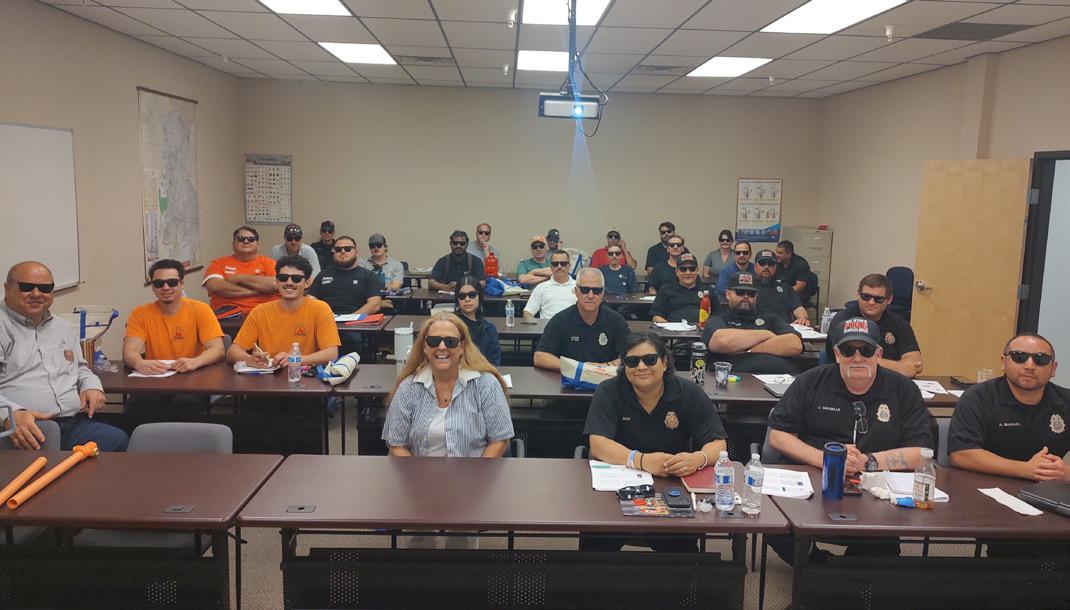
The Louisiana Fire Sprinkler Association (LFSA) held a social event on April 22 at Golf Suites. Guests played games and enjoyed food and drinks. Ameripipe and Ferguson Fire & Protection sponsored the event. The following day, LFSA had over 35 registrants attend seminars led by AFSA’s Vice President of Technical Services & Engineering John August Denhardt, P.E., FSFPE. a membership meeting, and board meeting at the Louisiana State Fire Marshal’s Office. Thank you to our lunch sponsor BRASSCO! Visit lafiresprinkler.org/.
AFSA’s New Mexico Chapter hosted a training event on July 18. AFSA’s Vice President of Engineering & Technical Services, John August Denhardt, P.E., FSFPE, presented fire pump and NFPA 13 updates. The attendees enjoyed lunch and mingling during their breaks. Door prizes were given to each attendee throughout the day. Everyone received various items such as hats, charging cords, thermos cups, picnic blankets, sunglasses, and fire extinguishers. The event concluded with a group photo. For more information on upcoming chapter events, contact Chapter Executive Director/Treasurer Renee Nix via email at rnix@santafecountynm.gov.
In June 2024, students put on their hard hats and continued the 20th iteration of the Henrico Career & Technical Education’s House Building Project. Henrico CTE took this innovative construction project to the next level, teaming up with the AFSA Virginia Chapter to build up life-ready skills and community partnerships with a first-of-its-kind sprinkler installation project.
Twenty-eight students from the Summer Building Trades Program took on the sprinkler installation project, which, according to AFSA, is the first sprinkler installation performed by an organized high school or technical education class in the state or country. These students are rising 10th graders who are exploring potential trade career pathways at one of HCPS’ ACE Center programs.
The sprinkler project began with guidance and instruction from AFSA Virginia Chapter professionals as materials were delivered to
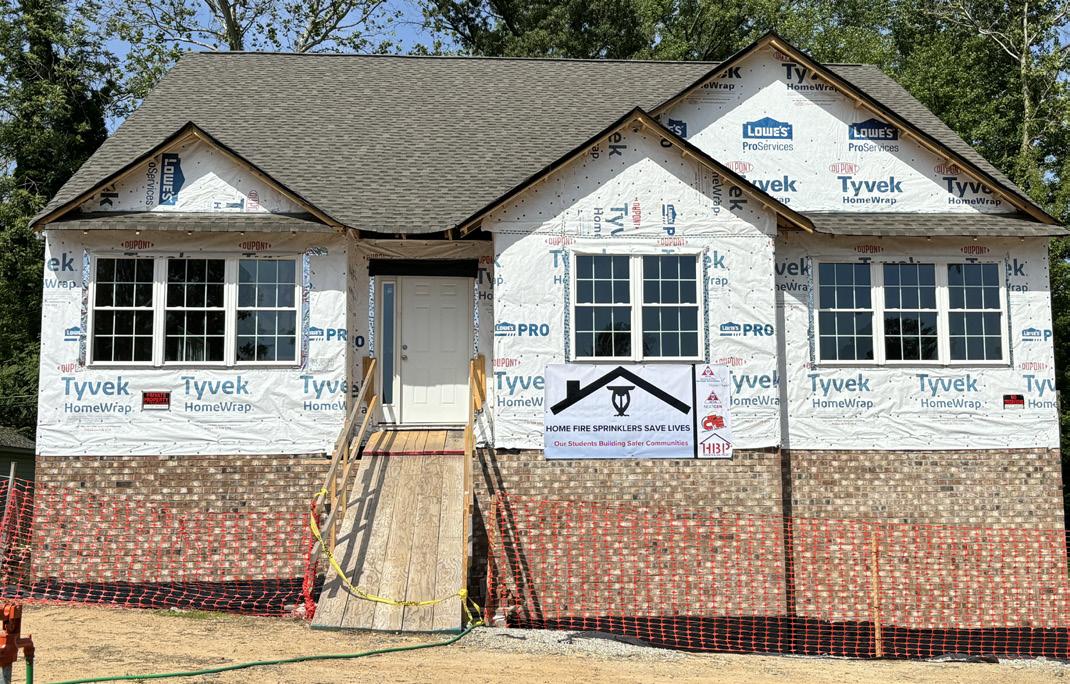
the construction site. Students also worked the following day, and the installation took approximately three weeks to complete in the threebedroom, two-bathroom house in Henrico that had its foundation built during the 2023-24 school year. It will be the first of the 20 single-family homes built as part of the House Building Project to feature a sprinkler system. Materials will be provided via donations from the Viking Corporation and General Air Products, with training and certification for the CPVC piping provided by the Lubrizol Corporation.
“The AFSA VA Chapter Board is wowed by the contributions and efforts of our contractor, vendor, designer and other members to make this project a reality,” said Bob Beckwith, AFSA VA president. “The students will have a great feeling of pride knowing that the fire sprinkler installation in the house will protect the new homeowners and possibly save lives. This project will serve as a successful example of what private and public sector collaboration and thinking outside of the box can achieve to make a difference for the community.”
Construction of the house, the collaborative effort of 200-600 Henrico CTE students, will conclude in the 2024-25 school year before it is eventually sold. Learn more about Henrico CTE, the Summer Building Trades Program and House Building Project at henricocte.com. For more information about the chapter and its activities, visit VirginiaAFSA.org. n
Register your team and consider sponsoring something great for FSCATX’s 35th Annual Charity Golf Tournament—35 years supporting Scottish Rite Children’s Hospital! The event will be held October 13, 2024, and there will be golf, raffles, fabulous player gifts, fun contests, and a live auction! Shotgun start at 10:30 a.m. at the Trophy Club Country Club. Join us for the best tournament of the year! Registration is now open at birdease.com/ScottishRite2024/. For more information on this and other FSCATX events, visit fscatx.org/. n
ALABAMA
Lee Seewald – Pres.
202-252-5101
Greg Willis – Exec. Dir. 334-567-4257
ARIZONA
Jason Williams – Chair
480-421-8411
Denniece Cooper - Exec. Dir. 480-282-5393
ARKANSAS
Randy Gilliam – Chair
479-646-8934
Coleman Farrar – Exec. Dir. 479-461-3863
CHESAPEAKE BAY
Jason Martin – Chair 240-848-2710
Danielle Fowler – Exec. Dir. 410-972-1122
COLORADO
Roger Wallace – Chair 719-337-6550
Kim Cook – Exec. Dir. 704-213-4368
DALLASFORT WORTH
CJ Bonczyk – Chair 817-529-1693
FLORIDA
Bob DiModica - Chair 239-514-7155
Jessica Cox – Exec. Dir. 813-784-3624
GEORGIA
Allen Cagle – Chair 770-554-5285
Tracy Williams – Exec. Dir. 770-355-0774
Dave Karrick – Chair 925-417-5550
Alicia Karrick – Exec. Dir. 510-398-9185
GREATER KANSAS CITY
Mark McKenzie – Chair 913-432-6688
Brett Heinrich – Exec. Dir. 785-825-7710
ILLINOIS-INDIANA
Skyler Bilbo – Chair 217-342-2242
Mitch Bortner – Vice Chair 206-348-0078
LOUISIANA
Randy Laguna – Chair
504-464-6236 ext 224
Ellen Ballard – Exec. Dir. 318-688-8800
MICHIGAN
Doug Irvine, Jr. – Chair 616-784-1644
Marc Huag – Chair 701-232-7008
Tina Hoff – Exec. Dir. 701-709-1899
NEW ENGLAND
Lisa DiRienzo – Chair 508-298-2134
Cheryl Tsetsilas – Exec. Dir. 603-890-3331
OKLAHOMA
AFFILIATE ofsa.info
Tim Hollon – Pres. 918-851-2416
NEW JERSEY
Thomas Bowlby, Jr. – Chair 908-226-5313
Victor Lugo – Exec. Dir. 201-635-0400
NEW MEXICO
Paul Chavez – Chair 505-898-9197
Renee Nix - ED/Treasurer 505-690-0913
NORTH CAROLINA
Mark Williams – Chair 704-425-4342
John Turnage – Exec. Dir. 919-624-3456
OHIO
Scott Huber – Exec. Dir. 513-942-1500
PACIFIC NORTHWEST
Chris Russell – Chair 360-734-4940
Ron Greenman – Exec. Dir. 253-576-9700
SACRAMENTO VALLEY
Holly Gray Salmon – Chair 916-296-9913
Paulene Norwood – Exec. Dir. 916-296-0635
SAN DIEGO
Mark Scott – Chair 619-778-2377
Rhonda Gudger – Exec. Dir. 951-326-4600
SCHUYLKILL
Dan Hinkle - Chair 215-778-5484
Meaghen Wills – Exec. Dir. 610-754-7836
SOUTH CAROLINA
Tyler Blume – Chair 864-909-2643
Ashley McAdams – Exec. Dir. 864-561-4088
SOUTHERN CALIFORNIA
Vahe Zohrabian – Chair 818-822-1797
TENNESSEE
Casey Milhorn – Chair 615-349-5278
David Pulliam– Exec. Dir. 901-484-0605
UTAH ROCKY MOUNTAIN
Mark Winder, Jr. – Chair 385-630-8064
Brent Heiner – Exec. Dir. 801-544-0363
VIRGINIA
Bob Beckwith – Chair 540-659-4675
Steve McGee – Exec. Dir. 757-544-0520
TEXAS AFFILIATE fscatx.org
David Stone – Pres. 713-466-9898
Sarah Kiefer – Exec. Dir. 512-844-6632
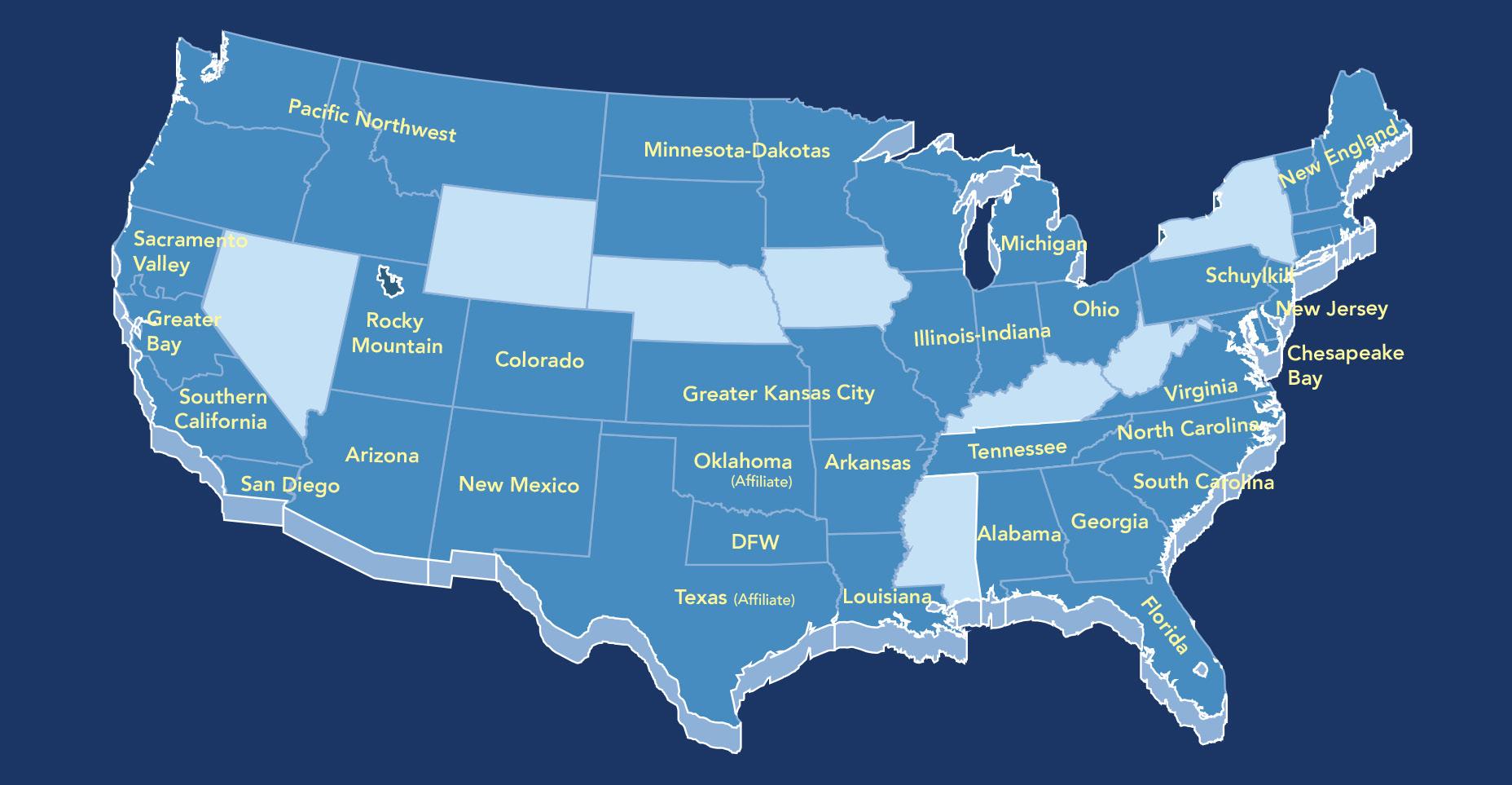
New members as of August 23, 2024
Fire Inspect Software, San Francisco, CA
NEW ASIA Co. Ltd, Yeoju-si, Gyeonggi-do, South Korea
USI, Raleigh, NC
Tower Consulting Engineers, East Elmhurst, NY
A2G Fire & Safety, LLC, Allen, TX
Accendo Fire Protection LLC, Greene, ME
Deesco Fire Protection LLC, Atlanta, GA
Fire Assessment, Clermont, FL
Fire Pro Services LLC, Mount Pleasant, NC
Los Padres Fire Protection, Santa Maria, CA
Maxim Fire Protection INC., Reseda, CA
Securance Technologies, Kenner, LA
Waystar Industries, Sea Bright, NJ
Burns & McDonnell (GFS.NTR), Dallas, TX
Fire Protection Group LLC, Odessa, FL
McKinstry, Portland, OR
Brandon Drews, Hoffman, Cypress, TX
Ron Kelley, Phoenix Automatic Sprinkler, Inc., Littleton, CO
Chantelle Abadie, Irvine, CA
Mandy Ayars, Buckeye, AZ
Daniel Azeff, Horsham, PA
Maos Baldwin, Albemarle, NC
Brett Ballentine, Golden, CO
Justin Barker, Aurora, CO
Alberto Barraza, Santa Fe, NM
John Barton, Los Angeles, CA
Kevin Bliese, Piedmont, SD
Yahines Bolden, Aurora, CO
John Carabillo, Santa Fe, NM
Mario Chavez, McAllen, TX
Andrew Chen, Los Gatos, CA
Christopher Chen, San Gabriel, CA
Erin Collins, Scotts Valley, CA
Michael Davis, Colorado Springs, CO
Lucas Dederich, Madison, WI
Noah Desmond, Long Beach, CA
Bruce Dile, Estancia, NM
Dylan Evanicki, Aurora, CO
Randy Ferguson, Estancia, NM
Randy Ferguson Jr., Estancia, NM
Vandaren Gantt, Jacksonville, FL
Aaron Garcia, Santa Fe, NM
Randon Grimes, Hudson, CO
Fred Heinrich, Londonderry, NH
Josiah Hernandez-Cruz, Aurora, CO
Michael Hunt, Summerville, SC
Douglas Kennedy, Los Angeles, CA
Andrew Kubinski, Charlotte, NC
Gricelda Lua Gomez, Covina, CA
Jeff Lutzke, Elkhart Lake, WI
Darren Martin, Chickasha, OK
Michael Mesco, King of Prussia, PA
Gib Moush, Santa Clara, CA
Rony Musones, Los Gatos, CA
Johnathan Peaden, Santa Fe, NM
Jordan Pivnik, Los Angeles, CA
Jordan Pivnik, Camarillo, CA
Joseph Pizzoferrato, Burlington, ON
David Rhoades, Loveland, CO
Matthew Rich, Sevierville, TN
Jeremy Roth, Denton, TX
David Salter, Irondale, AL
Candice Sena, Santa Fe, NM
Clinton Shepard, Denton, TX
Aaron Sroufe, Buckeye, AZ
Joseph Taylor, Riverside, CA
Glen Thompson, Campbell, CA
Guadalupe Toledo, Los Angeles, CA
Martin Whitson, Charlotte, NC
Thomas Wilson, Charlotte, NC
Joshua Wilson, Santa Fe, NM
Sarah Winter, Loveland, CO
Jun Zhang, Annapolis, MD
Total construction starts moved 10% higher in July to a seasonally adjusted annual rate of $1.1 trillion, according to Dodge Construction Network. Nonresidential buildings and infrastructure starts performed strongly during the month, countering a decline in residential starts. During the month, nonresidential buildings rose 25% and infrastructure starts increased by 19%. Residential starts fell 8% during the month. On a year-to-date basis through July, total construction starts were up 6% from the first seven months of 2023. Residential starts were up 11%, nonresidential buildings rose 5%, and nonbuilding starts were flat.
For the 12 months ending July 2024, total construction starts were up 3% from the 12 months ending July 2023. Nonresidential building starts were down 1%, residential starts were up 7%, and nonbuilding starts were up 5% on a 12-month rolling sum basis.
“Construction starts showed great promise in July,” said Richard Branch, chief economist of Dodge Construction Network. “However, the short-term remains questionable due to high interest rates. The Federal Reserve is likely to cut interest rates in September, which will, over time, make market conditions more conducive to moving projects forward. In the meantime, construction starts will likely remain volatile over the next few months.” n
Total construction starts lost 19% in June, falling to a seasonally adjusted annual rate of $1.0 trillion, according to Dodge Construction Network. Much of the decline was due to a stark decline in utility/gas starts following a strong May that saw several megaprojects get underway. During the month, nonbuilding starts fell 46% (following a 49% gain in May), while nonresidential starts fell 13%. Residential starts rose 9% during the month.
On a year-to-date basis through June, total construction starts were up 7% from the first six months of 2023. Residential starts were up 14%, while nonbuilding starts gained 8%, and nonresidential building starts rose 1%.
For the 12 months ending June 2024, total construction starts were up 1% from the 12 months ending June 2023. Nonresidential building starts were down 7%, residential starts were up 7%, and nonbuilding starts were up 8% on a 12-month rolling sum basis.
“The construction market remains sluggish as high interest rates continue to reverberate through the sector,” said Richard Branch, chief economist of Dodge Construction Network. “However, the Dodge Momentum Index, which tracks nonresidential building projects entering the planning phase, has been reasonably steady over the last year indicating that owners and developers remain cautiously optimistic that the conditions will be more conducive to construction in the future. But moribund starts activity means that these projects are piling up like water behind a dam. Lower rates in 2024 will allow these projects to start flowing again, resulting in a quicker pace of activity towards year-end.” n MONTHLY SUMMARY OF CONSTRUCTION CONTRACT VALUE
Prepared
Prepared

AFSA’s Fire Pump ITM Workshop provides ITM technicians, Authorities Having Jurisdiction (AHJs), and facilities managers with comprehensive knowledge and practical skills for fire pump installations and the necessary ITM procedures.
Participants will understand the key differences between diesel and electric-driven fire pumps, engage in hands-on exercises to perform no-flow and full-flow fire pump tests, and ITM requirements for water storage tanks. Hands-on activities include energy diffuser selection, data acquisition, supply graphing, and data interpretation.

The Reliable Automatic Sprinkler Co. Inc. announces cULus Listing for its compact K25.2 Pframe Early Suppression Fast Response Sprinkler. The Model P25 is an Early Suppression Fast Response (ESFR) fire sprinkler with a nominal K-factor of 25.2 (360 metric). For systems designed in accordance with NFPA 13 standards, the P25 is considered an ESFR fire sprinkler. FM Approvals classifies the P25 as a quickresponse storage and non-storage sprinkler when used in accordance with FM Global Property Loss Prevention Data Sheets.
In addition to the general cULus Listing, the Model P25 ESFR sprinkler in 212°F (100°C) temperature rating also has a cULus Specific Application Listing for protection of Class I-IV and cartoned unexpanded Group A plastic commodity in single- and double-row open frame racks for storage up to 40 ft (12.2 m) tall under ceiling heights up to 48 ft (14.6 m) where aisles of 5 ft (1.5 m) or greater are provided. Visit ReliableSprinkler.com.

Watts has introduced the Series 843H plate strainer which comes standard with Watts’ exclusive ArmorTek™ advanced coating system. With an eight-year Microbiologically Induced
Corrosion (MIC) warranty, this advanced patent pending coating technology provides three layers of protection to create an effective barrier, dramatically increasing resistance to corrosion.
First, ArmorTek features an anti-corrosion primer containing an electrochemical corrosion inhibitor, which significantly slows the spread of corrosion if the metal substrate becomes exposed due to wear or impact. Second, it incorporates a microbial inhibitor to curb the growth of bacteria that causes MIC, further slowing the spread of corrosion and limiting the formation of tubercles that can clog or foul downstream equipment. A robust topcoat is specially designed to bond to the primer below, providing a high-strength barrier between the iron substrate and water. Visit Watts.com/ArmorTek.

Armstrong has introduced new, larger sizes of the Design Envelope Tango, a compact, lowcarbon dual pump that ensures uninterrupted service, even during maintenance. The Design Envelope Tango includes two motors and two impeller assemblies in a single casing. Integrated valves can isolate one side of the pump for service, without interrupting flow or affecting occupant comfort.
New sizes are now available with motors ranging from 15 to 40 horsepower and are capable of serving applications up to 2,000 GPM or 160 ft of pressure.
Design Envelope Tango is a compact solution that reduces installation costs. Because the two rotating devices share a single casing, installation requires less piping. In addition, the Vertical In-Line orientation means the pump is installed in the piping and does not require an inertia base. Visit ArmstrongFluidTechnology.com.
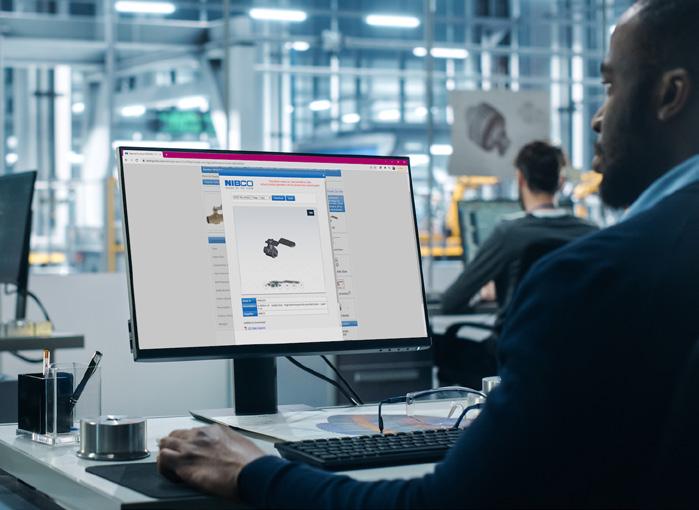
NIBCO INC. recently updated its BIM models to improve functionality across the Autodesk® Revit® platform. To better integrate with Autodesk® Revit™, NIBCO converted its valve CAD models to a leaner file that is compatible with Fabrication CADmep™ toolset. It also repositioned its connector points to improve fabrication spooling accuracy.
“These updates help us deliver the capable content our users request,” explains David Bobo, senior director, product engineering. “The ability to deliver lightweight and fully functional BIM files from our live database sets us apart from our competition who rely on pre-created Revit® files that may be years out of date.”
For easy accessibility, NIBCO has created an e-catalog so customers can access dynamically generated 2D and 3D CAD files for more than 11,000 common product SKUs in more than 25 formats including Revit® and CADmep™. NIBCO’s master library of critical geometry and specifications includes more than 150 product families.
Building design and construction professionals require a variety of BIM and CAD data to fulfill their project needs. They insist on accurate CAD data to ensure a trouble-free development experience. NIBCO prides itself on the quality of its CAD offering and makes adjustments to better serve its user community.
A family-owned and operated business since 1904, NIBCO INC. is a provider of valves, fittings, and flow control products for commercial, industrial and institutional construction, Navy marine markets, and residential and irrigation markets. NIBCO operates 14 manufacturing plants throughout the United States and globally. Visit nibco.com. n

Oct. 29 - Nov. 22 | Dallas, TX - Hybrid
Re-designed for a hybrid approach, with six live webinars offered first, followed by one week of in-person instruction. Students will study the installation & design approach requirements of NFPA 13 (2022), prepare system layout drawings, and perform hydraulic calculations by hand.
Nov. 5 - 15 | Dallas, TX - Hybrid
Experienced layout technicians will find this blended learning course useful to understand the tools they utilize in-depth and gain a deeper knowledge of layouts for standpipe systems, fire pumps, seismic protection, and the design requirements for general storage.
www.firesprinkler.org/design
NIBCO, INC. has announced the promotions of Brian Jaebker to chief financial officer and Todd Nowicki to senior vice president, finance. In Jaebker’s new role, he will be responsible for accounting, financial planning and analysis, treasury, tax and investor relations.
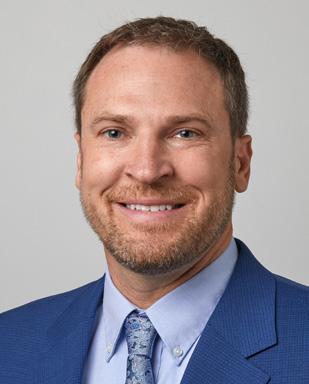
Jaebker has worked at NIBCO since 2014 and brings past accounting experience to his new role. During his career at NIBCO, he held several positions including director of operations accounting and corporate controller. Jaebker holds a bachelor’s degree in accounting and an MBA from Indiana University – Kelley School of Business in Bloomington, Ind. He also holds his certified public accountant license.
In Nowicki’s new role, he will be responsible for the pricing team, strategic initiatives and longrange planning. Nowicki joined NIBCO in 1984 and has worked as an industrial engineer, Goshen plant manager, director of residential manufacturing, division controller, operations accounting controller, corporate controller, director of operations and accounting and vice president of finance. Nowicki holds a bachelor’s degree in industrial management from Purdue University, West Lafayette, Ind. He also holds an MBA from Indiana University, South Bend, Ind. Visit NIBCO.com.

dent for 12 years, this medal recognizes individuals who have demonstrated outstanding advocacy in promoting fire safety for the general public and the fire service. The presentation of the James M. Shannon Advocacy Medal took place at the NFPA Stars at Night awards ceremony during the annual NFPA Conference & Expo® (C&E) in Orlando.
Hoover’s dedication to fire safety began as a junior firefighter and has continued throughout her distinguished career. She rose to the ranks of California State Fire Marshal and now serves as the deputy administrator of the USFA. Her journey is a testament to her unwavering commitment to protecting lives and properties from the devastating effects of fire.
One of Hoover’s most notable achievements was her steadfast advocacy for home fire sprinklers in California. Her efforts ensured that the requirement for sprinklers remained in effect, significantly enhancing fire safety standards and saving countless lives. Her advocacy extends far beyond this achievement, as she has been a relentless champion for fire safety issues nationwide. As Deputy Fire Administrator at the USFA, Hoover oversees the training of over 100,000 first responders annually, manages the National Fire Incident Reporting System, and leads critical fire prevention and public education programs. Her leadership and vision have profoundly impacted the fire service community. Visit NFPA.org.
The National Fire Protection Association® (NFPA®) announced that Tonya Hoover, deputy administrator of the United States Fire Administration (USFA), was awarded the 2024 James M. Shannon Advocacy Medal. Established in honor of Jim Shannon, who served as NFPA presi-

Armstrong Fluid Technology announces that Anish Suthesh Arul has been promoted to regional manager for North America. In his new role, he will manage both the US and Canadian regional sales enhancement centers, Armstrong’s two largest global markets.

ing from the University of Buffalo and is completing an Executive MBA program. For more details, visit ArmstrongFluidTechnology.com.
Arul has been with Armstrong for five years, most recently as applications engineer specializing in project management. Prior to joining Armstrong, he served in a variety of lead roles with the University of Buffalo Engineering and Applied Sciences Department. Arul has a Bachelor of Science degree in Mechanical Engineer-
The National Fire Protection Association® (NFPA®) announced that William E. Peterson, senior vice president at Strategic Government Resources, was awarded the 2024 Standards Medal. This prestigious award recognizes and honors outstanding contributions to fire safety and the development of NFPA codes and standards. It is the most distinguished award given by the NFPA Standards Council. The presentation of the Standards Medal took place at the NFPA Stars at Night awards ceremony during the annual NFPA Conference & Expo® (C&E) in Orlando.
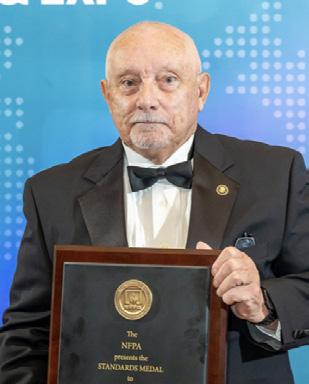
Peterson’s nearly six decades of work to secure safety are a testament to his fire and emergency management leadership. His involvement with NFPA dates back to 1977 when he became a Technical Committee Member on Fire Service Training.
Peterson’s journey began as a volunteer firefighter and led to his role as a fire chief and emergency management coordinator for the City of Plano, Texas. He was later appointed FEMA Region 6 Administrator, where he led federal emergency management activities across five states. Peterson has continued his extensive involvement with NFPA, including tenures as a former Standards Council member and a past NFPA board of directors member. His involvement continues today, including being the immediate past chair of the Correlating Committee on Professional Qualifications. For more details, visit NFPA.org.
The National Fire Protection Association (NFPA) Fire Sprinkler Initiative and the Home Fire Sprinkler Coalition (HFSC) have awarded the U.S. and Canadian Bringing Safety Home awards to Chief David Pendleton, Saco (Maine) Fire Department and Chief Ryan Schell, Central York Fire Service.
This award honors fire safety advocates in North America who diligently promote the importance of home fire sprinklers and use HFSC educational material, NFPA data, and Fire Sprinkler Initiative resources to educate decision-makers about the importance of home fire sprinklers.
rials and demonstrates outstanding service in reaching out to the community to address their evolving fire safety needs.

Pendleton was nominated by the Massachusetts Sprinkler Coalition because of his strong advocacy and efforts to educate the public and elected officials about home fire sprinklers. He successfully countered misinformation with facts about the economic benefits to the community. His efforts resulted in the Town Council voting in favor of protecting all new one- and two-family homes in Saco with fire sprinklers.
Schell was nominated by Scott Pugsley, Seneca Polytechnic School of Fire Protection. He is the first Canadian recipient of the award. He was selected because he organized educational events, advocated for sprinkler inclusion in building permit applications, built partnerships and conducted public demonstrations. His efforts increased awareness, debunked myths, and ultimately led protecting an entire subdivision within his jurisdiction with home fire sprinklers. Visit HomeFireSprinkler.org.

Peace has shown exceptional dedication and innovation in fire and life safety education, particularly in reaching vulnerable populations in her community. As an Educational Messaging Advisory Committee member, she uses NFPA programs to enhance her outreach efforts. She strongly advocates for Fire Prevention Week™ each October and promotes wildfire education through initiatives like Outthink Wildfire™.
Visit NFPA.org.
Telgian Fire Safety announces the appointment of Paul Martin, CPA as vice president of finance/controller. His responsibilities include overseeing and preparing operating budgets and financial reporting, as well as performing essential financial duties related to operations and payroll.

A highly accomplished accounting professional, Martin possesses extensive experience in revenue, payroll, forecasting, cash flow fore-




The National Fire Protection Association® (NFPA®) announces that Sylvia Peace, fire and life safety educator for the Greenville Fire Department in Texas, has been recognized as the 2024 Fire and Life Safety Educator of the Year. She received her award at the annual Stars at Night Awards gala during the NFPA Conference & Expo in Orlando on June 16.
Each year, NFPA presents this award to a dedicated educator who is employed by a local fire department or fire marshal’s office in the U.S. or Canada. The recipient of this award consistently and creatively utilizes NFPA’s mate-
cast, margin analysis and budgeting. Prior to joining Telgian, he served as controller for a trio of Flint Group companies with revenues exceeding $75M. There he led the accounting and finance team responsible for balance sheets, income statements and cash forecasting in the largest Flint Group regional market. Visit Telgian.com.
and standards. Awards were presented to 24 individuals at the association’s Technical Session, which immediately follows the NFPA Conference & Expo, June 17-19, in Orlando. Following is the list of this year’s award recipients.

Telgian Engineering & Consulting (TEC) announces the appointment of Darion Morgan, CPA as vice president of finance/ controller. Morgan’s responsibilities include leadership of all of TEC’s financial aspects including planning, compliance and reporting, as well as providing business intelligence and insights to our operations and business development teams. Additionally, Morgan will support our continued growth efforts as we enter our next phase of growth and expansion.
Morgan brings more than 25 years of finance experience to Telgian, including extensive knowledge of budgeting, forecasting, financial planning and analysis, accounts payable and receivable, taxes, external audit management, Treasury management, bank negotiations and contract. Prior to joining TEC, Morgan served as Chief Financial Officer for The Ginn Group in Peachtree City, Ga. Morgan earned his Bachelor of Science Degree Business Management with an Accounting Concentration from Emory and Henry College and a Master’s in Accounting and Financial Management from Keller Graduate School of Management. He also completed the Minority Business Leader Program at Dartmouth College, Tuck School of Business. Visit Telgian.com.
Each year, the NFPA Standards Council recognizes individuals for outstanding service to the organization in the development of codes
The 2024 recipient of the Special Achievement Award is Dr. Kathryn H. Floyd, The College of William & Mary. The 2024 recipients for the Committee Service Awards are Weston C. Baker, Merton W. Bunker, Dan Chisholm, Sr., Dr. Shane M. Clary, David W. Frable, Dan A. Guaricci, Larry Keeping, Chief Randy J. Krause, Kim I. MacCartney, Maria Marks, Leo F. Martin, Jr., Captain John J. McDevitt, Warren Olsen, Keith Pardoe, Brian N. Polk, Jack Poole, Peter T. Schwab, Matthew M. Shanks, Jeffery W. Sutton, William B. Till, Jr., Nancy J. Trench, Allyn J. Vaughn, and Charles J. Wright. Visit NFPA.org.
Watts has announced the recipients of its inaugural Backflow Hero Award. Recipients were selected by the Watts backflow leadership team from nominations from the Watts sales organization and rep network. The Backflow Hero Award recognizes those who have made a significant impact in the field of backflow prevention and individuals that embody the following qualities: Passion for Protecting Drinking Water: Demonstrates an unwavering commitment to safeguarding drinking water from the dangers of backflow; Innovative and Creative Thinking: Generates fresh, inventive ideas around backflow prevention; Commitment to Education: Actively seeks and provides continuing education about the importance and methods of backflow prevention; and Enforcement of Best Practices: Upholds and promotes the highest standards and best practices in backflow prevention.
The 2024 Backflow Hero Award recipients are Jim Purzycki, Backflow Apparatus and Valve Company (BAVCO) and Dave Watson, Dave Watson Associates. Purzycki is a highly experienced expert in backflow prevention and cross connection control, with over 40 years of dedication to the field. Water agency personnel frequently seek his advice, and many of his innovative ideas have influenced backflow products available today.

He is deeply committed to education, having served as an instructor and moderator at numerous backflow and water conferences nationwide. Purzycki remains an active mentor, teaching others about backflow prevention.
Purzycki is heavily involved with the American Backflow Prevention Association (ABPA) at both national and local levels. He collaborates closely with manufacturers and approval bodies like the University of Southern California Foundation for Cross-Connection Control and Hydraulic Research. He has developed a comprehensive catalog of spec sheets, models, and parts for various assemblies and maintains a website with training videos on backflow assembly repair, installation, and maintenance. His three warehouse locations cover the entire US, reflecting his lifelong commitment to backflow prevention across all brands.
Watson began working in the cross-connection control field in the 1970s, traveling from town to town to explain the need for CCC programs as the codes were being developed. He is dedicated to finding the best products to protect systems while managing the impact on customers. Over the years, Watson has recommended vacuum breaker designs, offered constructive improvement ideas, and produced backflow preventer repair videos.
Watson teaches at all Michigan Plumbing & Mechanical Contractor’s Association (MPMCA) cross connection testing classes. He also presents to inspector groups such as PIAM, Tri-County, and SEMPIA. In his early years, he trained pipe fitters at GM, Ford, and Chrysler. Watson constantly interacts with local code authorities, addressing product listings and installation issues, and speaks directly with customers to gather feedback.
To learn more, visit watts.com/our-story/ backflow-hero-award. n



The National Fire Protection Association® (NFPA®) released its “Fatal Firefighter Injuries in the U.S. in 2023” report, which showed a total of 89 on-duty U.S. firefighter fatalities in 2023, representing an eight percent decline over the 97 fatal injuries in 2022. Of these deaths, 50 were volunteer firefighters and 30 were career firefighters; the nine non-municipal firefighter fatalities included five full-time state forestry rangers or technicians, one state forestry contractor, one full-time federal forest service firefighter, and two military firefighters.
The firefighter fatalities in 2023 are higher than the totals in recent years; it’s also the second-highest number since 2013, when 98 onduty fatal injuries were reported. However, much of the increase over the past two years reflects the inclusion of cardiac deaths and strokes or aneurysms occurring within 24 hours of duty, irrespective of manifested or reported symptoms while on duty. These deaths were previously not counted unless there was a specific physical complaint while the firefighter was on duty.
According to the newly released report, reductions in the number of fatalities among career firefighters accounted for most of the decline (23 percent), from 39 deaths in 2022 to 30 in 2023. In addition, while heart attacks remain the leading medical cause of death, there was a 20 percent decline in the number of career firefighter heart attacks—from 15 fatalities in 2022 to 12 in 2023. Visit NFPA.org.
The SFPE Foundation, a charitable organization focused on enhancing the scientific understanding of fire and its interaction with the social, natural, and built environments, is pleased to celebrate the 20 recipients of its 2024 awards, as follows:
Margaret McNamee, Ph.D. (Lund University), Brian Y. Lattimer, Ph.D (Virginia Tech); Xinyan Huang, Ph.D. (Hong Kong Polytechnic University); Michael A. Delichatsios, Ph.D. (Northeastern University); Yiannis A. Levendis, Ph.D. (Northeastern University); Kevin Kochersberger, Ph.D. (Virginia Tech); Samuel Manzello, Ph.D. (Tohoku University); Peter Frank (Evans Consult-
ing); Tombo Jones (Virginia Tech - FAA Designated UAS Test Site); Jordi Salvador (BCN Drone Center); Conrad Delgado (BCN Drone Center); Eduard Angelats (Centre Tecnològic de Telecomunicacions de Catalunya (CTTC); M. Eulàlia Parés (Centre Tecnològic de Telecomunicacions de Catalunya (CTTC); David Martín (Pau Costa Foundation); Sara McAllister, Ph.D. (Missoula Fire Sciences Laboratory); Sayaka Suzuki, Ph.D. (Tokyo Institute of Technology); Bronwyn Forrest, PhD Student; Samuel Lovett, Master’s student; Siyan Wang, PhD candidate; and Ting Xia, PhD student. Visit SFPE.org.
The National Fire Protection Association® (NFPA®) announced at Fire Rescue International (FRI) in Dallas that it is licensing CRAIG 1300®, its digital community risk assessment (CRA) framework, to the Emergency Services Consulting International (ESCI), the consulting arm of the International Association of Fire Chiefs (IAFC).
Called the ESCI Community Risk Hub powered by CRAIG 1300®, this new tool is built on Esri’s ArcGIS platform. It allows users to visualize risk assessment data; plan and track risk reduction activities; and evaluate success of local initiatives aligned to NFPA 1300, Standard on Community Risk Assessment and Community Risk Reduction Plan Development. ESCI is a partner of Environmental Systems Research Institute, Inc. (Esri). Visit NFPA.org/craig1300.
Vector Solutions announced that it is working with the National Fire Protection Association® (NFPA®) to host NFPA’s virtual training program for first responders. NFPA received a grant from the U.S. Department of Energy to build this training, which will enhance firefighter competency in responding to emerging distributed energy technologies and lithium-ion battery fires.
The NFPA Fire Incident Response Simulated Training (FIRST) Application offers a game-like simulated training experience designed to address renewable technology emerging hazards. This immersive program allows firefighters to train in realistic virtual scenarios, such as fight-
ing electric vehicle and energy storage fires in residential garages. The application is based on real-world test data, enabling firefighters to engage in interactive, multi-user simulations that mirror actual incidents. This training is engineered to help improve their response times and effectiveness, ultimately enhancing public safety. Visit NFPA.org.
The SFPE Foundation, in collaboration with GCI Founding Partner Jensen Hughes, proudly announces the inaugural Grand Challenges Initiative (GCI) Applied Research Fellow in Climate Change (WUI Fires) for 2024-2025: Amy Metz, PhD student, Oregon State University. Project Title: Predicting VOC Contamination in Water Distribution Systems Following Wildfire. Additional information about the SFPE Foundation may be found at sfpe.org/foundation. n

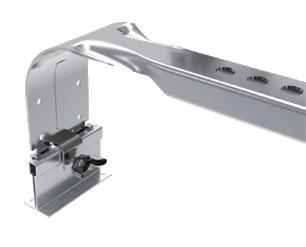









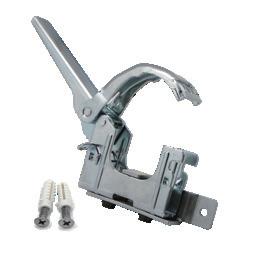


Online testing accessible 24/7
Expert instructor support
Proctored assessments
10 Months/Level
Convenient format and schedule Live Virtual Apprentice
Level 1
Class Starts January, 2025
Level 2
Class Starts March, 2025
Level 3
Class Starts February, 2025

